












































CJ4 Gen3 launch customer
Ryan Samples (left) and Lannie O’Bannion, Textron Aviation’s senior v-p of global sales and flight operations.














































CJ4 Gen3 launch customer
Ryan Samples (left) and Lannie O’Bannion, Textron Aviation’s senior v-p of global sales and flight operations.
By Matt Thurber and Amy Wilder
Textron Aviation on Monday unveiled its latest jet to get a major upgrade: the Cessna Citation CJ4 Gen3, which will feature Garmin’s new G3000 Prime touchscreen avionics suite and other refinements.
Textron Aviation arrived at NBAA-BACE with the launch customer in hand, naming Ryan Samples as the first in line for the newest CJ4. Samples, who is a pilot and identified himself as a founder and CEO of a “technology company based in Oakland,” reminisced about the journey from
learning to ride a bike to driving a car and progressing into aviation and the exponential freedom each new leap brought. The CJ4 Gen3 for him is “a culmination of that freedom.”
The CJ4 Gen3 prototype completed its inaugural flight in early October, embarking on a campaign that is anticipated to culminate in service entry in 2026.
Chris Hearne, Textron’s senior vice president of engineering and programs, noted that the aircraft performed as expected, paving the way for rigorous testing ahead of certification and customer delivery.
continues on page 69
Hurricane relief
Daher works with Kodiak and TBM owners to ferry supplies and rescue animals | 30
Pilot support
MedAire builds a peerto-peer support network for flight crews | 42
EBACE show lives on EBAA executive confirms the show will proceed as planned in 2025 despite NBAA’s exit | 65
AR/VR technology
CAE’s Apple Vision Pro app makes pilot training more immersive | 68 alerts























for Jet ConneX. Expect more than fast. JetXP

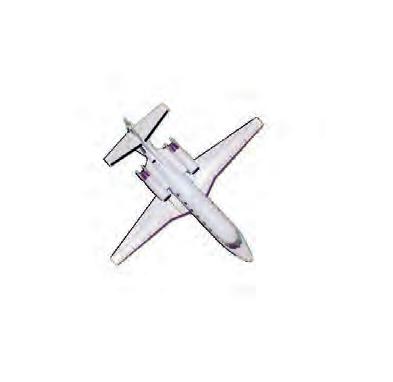
Had enough of empty speed promises? Viasat’s JetXP enhancement program puts experience first, unleashing the full power of our network for business aviation customers. Our expanded capacity, increased network prioritization and uncapped speeds, delivers even more reliable, consistent and snappy Wi-Fi. Anytime. Anywhere.
By Sarah Rose
Against the backdrop of a partisan and divided presidential election season, NBAA president and CEO Ed Bolen took time during an NBAABACE newsmakers luncheon to praise lawmakers for their bipartisan efforts to pass the FAA reauthorization bill as well as to confirm new FAA Administrator Michael Whitaker.
Bolen discussed that bipartisanship as he moderated a roundtable with U.S. House of Representatives Transportation and Infrastructure Committee Chair Rep. Sam Graves (R-Missouri) and Ranking Member Rep. Rick Larsen (D-Washington).
“Earlier this year, we saw in one of the most political environments at the very start of an intense election year the vast majority of the House of Representatives and the Senate come together to pass an FAA reauthorization bill. That is significant in so many ways,” Bolen said.
Larsen underscored that the overwhelming vote for the reauthorization sets a mandate for whichever administration takes office next year.
“Presidents come and go, Congress is forever,” he joked. “In this sense, we passed the bill 387 to 26 out of the House of Representatives—and I know where those 26 people live—and with 84 out of the Senate. It sends a bicameral, bipartisan message about the bill that we passed. So, regardless of which administration comes in, they’re not going to be able to come to us and say, ‘Well, you didn’t mean to do that.’”
Graves made a note of Larsen’s idea for him to make the introductory statement

during Whitaker’s confirmation process in the Senate.
“He asked me if I would do his introduction to the Senate, which is highly unusual for a House member to do that,” Graves said. “But being a Republican, it did short-circuit the opposition, it let the air out of its sails, so to speak.”
Larsen also made note of the uncertainty around the election season.“There’s one thing Trump and Harris have in common, and it’s that neither of them have talked about transportation,” he said.
Also during the newsmakers luncheon, Bolen reiterated NBAA-BACE’s central themes are focused on what’s ahead for the industry.“Our industry is accelerated on our way to that zero-carbon emissions, and we’re doing it with a sense of urgency,” he said. “We’re fostering aviation safety and technologies. Of course, we are going to celebrate and inspire, attract, develop,
NBAA president and CEO Ed Bolen (left) speaks at an invitation-only newsmakers luncheon on Monday at NBAA-BACE 2024 in Las Vegas.
and retain a new generation of workforce.”
Bolen further took a moment to help announce the National Aviation 2025 Hall of Fame Class alongside National Aviation Hall of Fame president and CEO Aimee Maruyama.
The six 2025 Hall of Fame inductees are pilot Julie Elizabeth Clark, former National Transportation Safety Board member and AIN contributor John Goglia, astronaut Mae Jemison, NBAA chair emeritus and, retired Air Force pilot Gen. Lloyd W. “Fig” Newton, pilot Phoebe Fairgrave Omlie, and engineer and Robinson Helicopter founder Frank Robinson.
“The individuals we recognize are not only pioneers and trailblazers, they are living legacies. They continue to influence the way we think about life and its possibilities and we’re celebrating their achievements,” said Maruyama. “It’s not just about looking back, it’s about also sparking the imagination of tomorrow’s innovators.” z
By Curt Epstein
As the testing program for Bombardier’s new flagship Global 8000 nears completion, the Canadian airframer announced that it has begun construction of the first production model of the ultra-long-range business jet. It will be the first built from the wheels up as an 8000, since modified Global 7500s were used for the test program.
At a press conference Monday morning at NBAA-BACE, Éric Martel, the OEM’s president and CEO, told a standing-room-only audience that the certification of the twinjet—a longer-legged, faster variant of the Global 7500—is expected to go smoothly as it approached 300 hours of testing.
“We do flight testing across the product, so we are extremely happy with the result; the industry’s fastest speed,
continues on page 69

A more customer-centric approach you can count on. CAE is constantly working to more comprehensively and precisely meet your needs. Our more personalized and seamless training experiences, modern learning tools and innovative methods, and most highly-qualifed instructor workforce, are all brought to focus on your purpose— that of enhancing and ensuring team performance, readiness, and safety.
Today and tomorrow, we make sure you’re ready for the moments that matter.
By Curt Epstein
Honeywell Aerospace’s latest forecast calls for the delivery of 8,500 new business jets worth $280 billion over the next decade. The Arizona-based engine and avionics maker released the results from its 33rd annual Global Business Aviation Outlook on Sunday night on the eve of NBAA’s Business Aviation Convention and Exhibition in Las Vegas.
The number of jet deliveries it expects in the 2032/2033 timeframe remains unchanged from last year’s prognostication, reaching the 900-per-year unit plateau for the first time since 2008. However, the value has increased slightly.
To gather its results for the 10-year forecast, Honeywell surveyed 375 non-fractional operators representing 1,488 business aircraft worldwide. For the first half of the decade, purchase plans remained on par with those reported in last year’s survey, indicating demand for new aircraft is stabilizing above pre-pandemic levels.
The survey anticipates that large cabin jets will account for one-third of the delivery total and two-thirds of the revenue value over the next five years.
“The business aviation industry is in a prolonged period of healthy growth, and we don’t see that positive trend changing any time soon,” said Heath Patrick, Honeywell Aerospace Technologies’ president for the Americas aftermarket. “Business aviation continues to see more users and, as a result, manufacturers are ramping up production to keep pace with growing demand, a trend we expect to continue for the foreseeable future.”
For 2025, the forecast calls for deliveries to increase by 12% over this year’s anticipated total of 750 jets.
“We were a little hampered between 2020 and 2023 because of supply chain constraints,” added Kevin Schwab, a systems engineer with Honeywell and lead analyst on this year’s survey. “We’re seeing some improvements in the supply chain, and that is enabling the OEMs
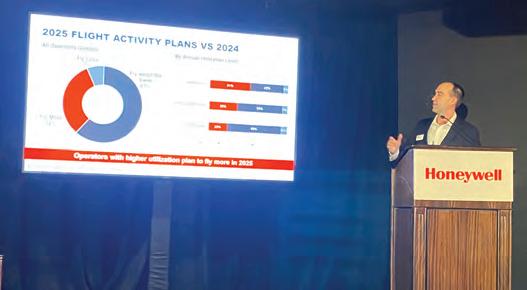
to have these production rate increases.” Next year, the company predicts 16% more business jet deliveries than in pre-Covid 2019.
North America is expected to receive twothirds of the total, followed by 13% to Europe, 10% to Latin America, 7% to Asia Pacific, and the remaining 3% to the Middle East.
The survey asked operators about their anticipated flight activity in 2025, and an overwhelming 90% indicated they expected to fly the same or more than they did this year, echoing last year’s results and indicating continued optimism in the post-Covid period.
“The reduction in barriers to access business aviation in recent years, driven by the introduction of new shared access models, has enabled a persistent flow of new customers opting for business aviation alternatives for their travel needs,” the report stated.
Honeywell noted an uptick in flight activity in Latin America, particularly in Brazil, which Schwab believes correlates to increased nearterm aircraft purchase plans there.
New to this year’s survey, Honeywell asked operators to rank their aircraft purchase drivers for the first time. “We had 37 different individual drivers of purchase decisions, and we bucketed those into six different categories,” explained Schwab.
“About 82% of the operators said that performance is in their top three priorities when they go to buy a new jet, and 60% said that cost was in their top three,” Schwab added. Range
Kevin Schwab, a systems engineer with Honeywell Aerospace, served as lead analyst on the OEM’s Global Business Aviation Outlook. He presented the highlights of this year’s report on Sunday night on the eve of NBAA-BACE.
was the overall individual purchase driver, according to the respondents, followed by direct operating cost, maximum payload, field performance, and speed.
While the preowned aircraft market has cooled since the record low inventories of 2021 and 2022, Honeywell noted used jet values remain strong compared with those of the previous decade. The report predicts that while the inventory will slowly rise, prices should remain stable. Operators in the survey noted they expect to rely more heavily on the preowned market to expand their fleets than in previous years.
Sustainability was another topic touched on by the survey this year, with 85% indicating they view the acquisition of new, more fuel-efficient aircraft as the most effective method to reduce environmental impact.
Among those respondents who indicated they are proactively looking to reduce their carbon footprint, 55% said the use of sustainable aviation fuel figures into their efforts. When the survey respondents were asked what they view as the top hurdles to industry adoption of SAF, cost was mentioned most, followed by availability.
Schwab told AIN he was surprised by operators still citing risks to aircraft reliability, lack of environmental impact, and lack of awareness as hurdles. He suggested that there is still a great need for further industry education on the use and benefits of SAF.

by Sarah Rose
Embraer returns to NBAA-BACE enjoying a strong sales year and continued growth, including a nearly 50% jump in third-quarter business jet deliveries in the third quarter.
In the three months ending September 30, the company delivered 41 executive jets and 16 commercial jetliners, an overall increase of 33% year over year. This compares with 28 executive jets and 15 of its airliners a year ago.
Praetor deliveries in the quarter were notably up, reaching 19. This compares with nine in the same period of 2023. Phenom deliveries improved to 22, compared with 19 a year ago.
For the first nine months, the company has delivered 86 business jets and 42 airliners, up from 66 and 39, respectively a year ago.
The backlog of Embraer’s Executive Jets business unit reached $4.4 billion during the third quarter, a 3% increase from the same quarter last year but a 4% decrease from the second quarter of 2024.

Embraer reported the results as it prepared to arrive at BACE this week, where it is showcasingits Phenom 100, Phenom 300E, and Praetor 600 business jets. The Brazilian airframer is also touting the expansion of its owned MRO service center network.
As Embraer picks up the pace with business jet deliveries, the company remains focused on sustainability efforts. It flew to NBAA-BACE on sustainable aviation fuel and has committed to
Rolls-Royce has completed the flight-test campaign for the Pearl 10X turbofan it is developing for the in-development Dassault Falcon 10X business jet. Over the past six months, the powerplant has been evaluated on the engine maker’s Boeing 747 testbed aircraft, logging around 36,000 nm during the course of more than 25 flights conducted in the U.S.
During the tests, the engine was operated at a maximum altitude of 45,000 feet, with the testbed achieving a maximum speed of Mach 0.90. According to Rolls-Royce, the test campaign achieved all of its objectives
and gave the company confidence in the maturity of the program as it continues to work with Dassault on the 10X program.
NBAA’s “Green Pledge,” which includes reducing printed materials and committing to “sustainable practices” at industry events.
Michael Amalfitano, president and CEO of Embraer Executive Jets, was to participate at the NBAA-GAMA “Climbing Fast” media breakfast on Tuesday, discussing the industry’s mission to reach net zero aviation.
Amalfitano recently spoke about the industry’s challenges in the post-Covid economy at the JetNet IQ Summit in New York last month.“The supply chain is fractured in many ways,” he said. “That talent pool we lost takes time to recover.”
“You’ve got to go to the supplier. We have hundreds of people sitting with suppliers and addressing problems firsthand and resolving it in their space as partners so they can ramp up more quickly to deliver results,” Amalfitano said. “You gotta do the work; it’s not just fairy dust.”
According to Amalfitano, younger people are beginning to take an interest in the industry. He noted that creating opportunities for advancement and fair compensation is key.
C.A.
“On behalf of Rolls-Royce, I would like to extend my heartfelt thanks to our incredible global engineering and experimental test teams for their outstanding dedication and expertise in successfully completing the Pearl 10X flying testbed campaign,” said RollsRoyce Deutschland senior v-p Philipp Zeller. “This achievement is a testament to your commitment, innovation, and global collaboration and I am immensely proud of everything we have accomplished together.”
“The issue is not about simply hiring. It’s about training and investing dollars in the people so they can become master craftsmen and -women,” he said. “What happened during the pandemic is we lost the best talent in every aspect of aerospace. You have to hire the people and get them motivated, but you have to invest dollars to train them.” z

With FlightSafety International, you’re not just checking regulatory boxes. You’re pioneering a new standard of excellence in aviation using data analysis to train more e f ectively for the right safety risk areas. In fact, those who train with us are 12x more likely to avoid an incident or accident.
Learn about our industry-leading training at NBAA-BACE booth 2641.


By Charles Alcock
Sometimes being the alternative to the obvious course of action can be an ideal springboard for disruptive innovation in a market. That would appear to have been JSSI’s north star as it has navigated through 35 years of providing hourly cost maintenance (HCM) programs for business aircraft operators, taking on the role of the grit that yields pearls from oysters in an MRO sector that might otherwise be complacent through lack of competition.
But the company hasn’t just made its name for not being any one of the major airframe, engine, or aircraft parts OEMs, with the promise of a more competitive support service. It’s kept innovating to improve core offerings like Tip-to-Tail coverage as technology has evolved, and also to move into new areas, such as aircraft financing, and software and data.
JSSI’s Parts & Leasing (JPL) operation is a prime case in point, supplying not just HCM clients, but plenty of other operators too. Over the past decade, the team has taken a deep dive into the mysteries of gaps in inventories and supply chain headaches, which have rapidly risen to the top of habitual stress triggers in the business aviation sector.
Today, JPL has direct access to hardware from more than 600 vendors worldwide, with
a procurement team that provides 24/7 AOG support, sourcing what’s needed from wherever it may be most readily available. According to JSSI, the 100,000 or so parts it has in stock cover more than 80% of all business aircraft in service today.
Last year, JSSI launched its PartsHub eCommerce platform, which gives users access not only to available inventory but also to vital information about aircraft applicability, alternate options, and reliability data covering factors such as mean times before removal, reasons for removal, and a direct correlation between maintenance task numbers and specific parts. The service is free to use and includes thousands of pre-priced parts for those who just want to select and check out with no delay.
In the seven years since JSSI acquired and digitized respected industry data source Conklin & de Decker, the shared focus has been on expanding the horizons of data transparency and objectivity. Today, the platform provides users with the ability to compare more than 500 business aircraft, with operational and performance data presented without fear or favor.
In 2021, JSSI added the Traxxall and SierraTrax (now Aviator) platforms to its software
portfolio, providing clients with improved ways to track maintenance tasks. Traxxall now tracks the status of more than 4,000 aircraft for more than 17,000 customers in over 80 countries.
Aircraft financing is the group’s most recent diversification, with the launch of JSSI Aviation Capital in 2023. According to the company, its profound understanding of maintenance and aircraft values leaves it better placed to finance a wider array of transactions, including older assets, that may not be in the wheelhouses of most banks and finance providers. It can provide 100% assetbased financing lending directly against the asset value of the aircraft, but also commonly finances up to 65% loan-to-value.
Arguably, if JSSI didn’t exist, business aircraft operators would have no choice but to accept support programs their aircraft and engine manufacturers served up. “Our role in the market is to drive consumer choice, innovation, improved product and service quality, and affordability,” Francisco Zozaya, JSSI’s chief revenue officer, told AIN. “In a competitive environment, the market becomes more dynamic, and o ff erings improve. We have evolved from exclusively focusing on HCM programs to expand into synergistic areas and product lines.”


By Kerry Lynch
NBAA is making an encore appearance in Las Vegas for the second consecutive year under a four-year plan to anchor its hallmark BACE show at the entertainment mecca. Many of the expected features return, from the static display to expansive and creative exhibits, to a slate of high-level speakers accompanying myriad education sessions, to the all-important chance for the industry to reconnect face-toface and build on long-standing relationships and form new ones.
Yet all of this is occurring in an environment of change, both for the industry and the association.
In 2022, the association announced plans to trial a single location for the event that draws well more than 20,000 and at times has topped 30,000. Thus, NBAA-BACE will remain in the location at least through 2026.
The winnowing down to the single location had actually occurred over years for the event that requires adequate hotel space, an accessible alternative airport capable of housing more than 80 business aircraft on static display, and a convention center that can provide one million sq ft or more to accommodate the vast displays.
Having rotated between cities such as Dallas, New Orleans, and Atlanta, the growth of the event narrowed it to two locations: Orlando and Las Vegas. NBAA president and CEO Ed Bolen has remained positive about Orlando, telling AIN, “We love Orlando; we love everywhere we’ve been.”
But Las Vegas has always drawn well, and association executives pointed to the international nature of the city as a place that tends to attract high-net-worth individuals.
“Every time we have done a show in Las Vegas, there’s always a lot of enthusiasm about all the entertainment options, the food, the excitement, the quality of the hotels,” Bolen said. “Obviously, the city has always been a

great business-friendly place. There’s a good reason Las Vegas is the number-one convention spot in the U.S.”
And importantly for the vendors, it provides a base where they can store their displays without the expense of rotating locations. “We work hard to communicate with our exhibitors, our attendees, and our advisory council. There’s a multiple of factors we look into across the board, and we’re excited to be in Las Vegas on a multi-year program,” Bolen added.
Only two years in, the association is not confirming whether this will be permanent. “We’re constantly evaluating everything we do,” Bolen said. “Everything we do is forwardlooking.” But for now, indicators appear to favor Las Vegas.
The success of BACE takes a more central role since it has become NBAA’s lone major convention and exhibition. NBAA in August parted ways with the European Business Aviation Association on the European Business Aviation Convention and Exhibition (EBACE). The associations announced that EBAA was buying out NBAA’s stake in the annual event in Geneva.
NBAA had been a longtime partner with EBAA on the event launched in 2001. Its decision to pull out followed the quiet tabling of
the Asian Business Aviation Conference and Exhibition, which disappeared during Covid, and NBAA had stepped back from the Latin American Business Aviation Conference and Exhibition in 2007 after Associação Brasileira de Aviação Geral (ABAG) had expressed a desire to take the lead on the São Paulobased show.
This does not leave NBAA solely with BACE; in fact, the Washington-based association has a full plate of events that are more targeted either by region or niche, most of which are growing. Its regional forums in southeast Florida and White Plains, New York—as well as its Schedulers & Dispatchers Conference, which rotates locations—each attracts thousands, for instance. Each regional forum serves as a mini-BACE but with a more local flavor, complete with a static display, stands, and topical sessions.
The association has lined up seven events outside of BACE already for 2025: Winter Regional Forum, NBAA Leadership Conference, International Operators Conference, Schedulers & Dispatchers Conference, Maintenance Conference, Business Aviation Taxes Seminar, and White Plains Regional Forum.
The growth of these events, both in number and attendance, also is part of a larger trend
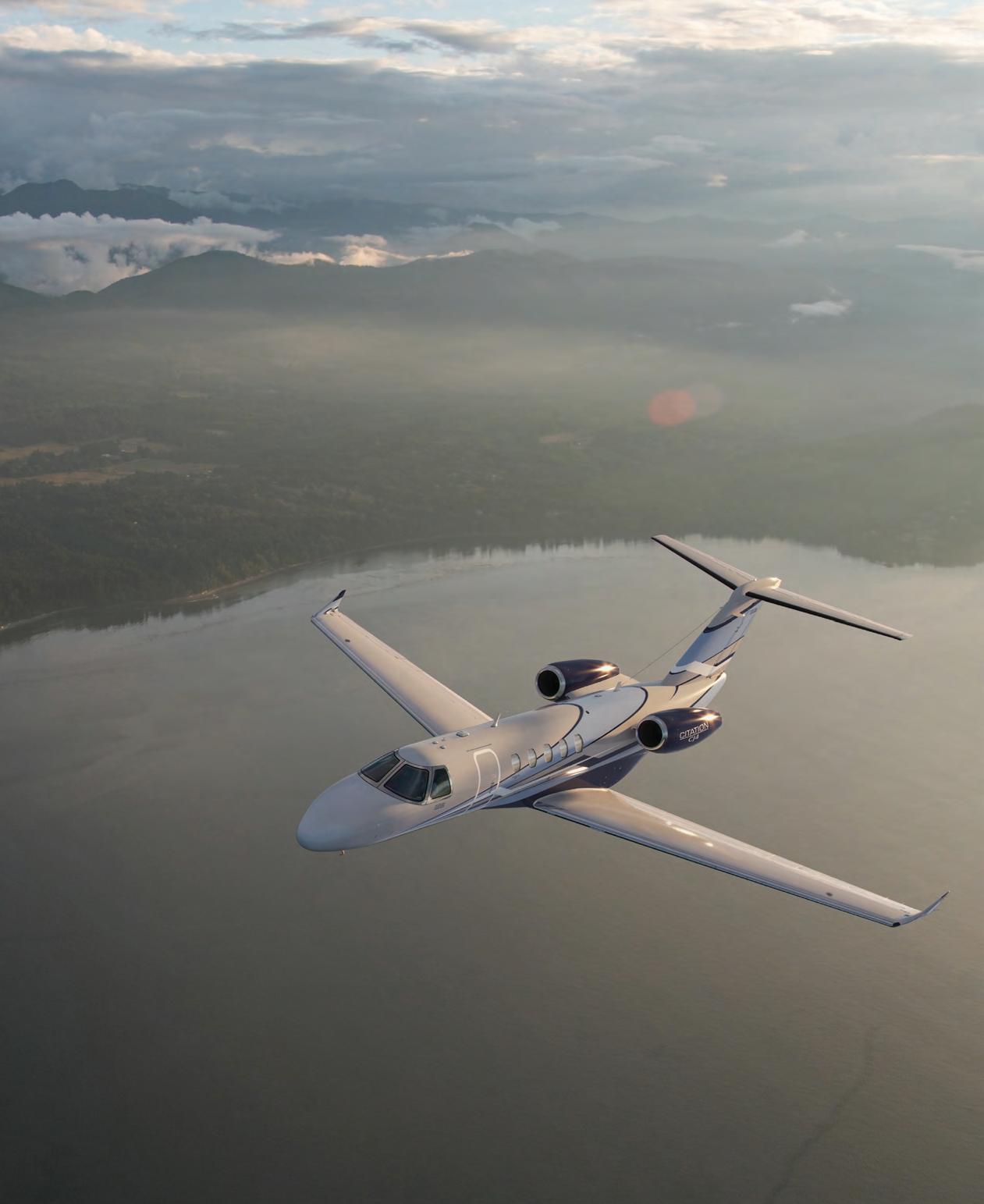
THE NEW CESSNA CITATION CJ4 GEN3
flight deck featuring autothrottles, emergency autoland and a quieter, more comfortable cabin. The CJ4® Gen3™ jet delivers what you need to fulfill your loftiest travel ambitions. .
The new Citation® CJ4® Gen3™ aircraft continues the Citation® brand’s five decades of business and general aviation dominance by introducing an array of advancements, including the newly announced Garmin® G3000® PRIME

Fun fact: a Cessna® Citation® jet takes o or lands every 35 seconds. Proof positive that it’s the world’s most popular business jet family. But the question is, how does Textron Aviation make the next great Citation® aircraft?
In interviewing some of the over 450 CJ4® series aircraft owners, Textron Aviation was able to capture their wish list. Surprisingly, the list wasn’t long, as they agreed that CJ4® jets are marvelous aircraft. Even so, they let the company know where they would like to see improvements.
Owners and pilots wanted the latest Garmin® avionics and cockpit ergonomics to reduce workload and facilitate more confident single-pilot operations. Passengers wanted a quieter cabin with an array of sustainability-focused materials. And everyone wanted the “next CJ4® jet” to deliver operational e ciency.
This customer feedback aided in the creation of the new Citation® CJ4® Gen3™ jet. From its Garmin® G3000® PRIME avionics suite with emergency autoland to its measurably quieter cabin, this is the most advanced, capable, comfortable, and confidence-inspiring Citation® jet series ever built.
In the world of single-pilot jets, the new-generation CJ4® Gen3™ aircraft will redefine the standard for operational ease, e ciency, confidence, and comfort.
An upgrade that pilots will benefit from throughout every phase of flight is the latest and most advanced Garmin® G3000® PRIME integrated avionics suite. Bigger displays, more information, faster processing, and easy-to-reach touchscreen controllers, enhance system operations and pilot confidence.
At the top of its list of “must-have” standard features is the revolutionary Garmin® Emergency Autoland system - a first for the Citation® Jet family. It’s a peace-of-mind boosting system everyone hopes to never use.
The Garmin® G3000® PRIME suite also includes 3D perspective topographic synthetic vision and the latest GWX™ 8000 StormOptix™ digital radar with Auto Mode, turbulence detection, and ground clutter suppression.
The next big CJ4® Gen3™ aircraft advancement on the list is the Garmin® full-regime autothrottles with under-speed and

over-speed protection, which are significant advancements in optimizing the management of the Williams® FJ44-4A engines while minimizing pilot workload.
Being a true “pilot’s airplane,” the CJ4® Gen3™ jet enhancements also include upgrades to the already comfortable and functional cockpit, including upgraded/enhanced lighting in the cockpit overhead and side storage pockets. When it comes to making the most advanced Citation® jet, every detail matters.
ENTER A CABIN THAT IS QUIETER TODAY AND MORE SUSTAINABLE FOR TOMORROW.
Unlike the Garmin® upgrades to the CJ4® Gen3™ jet cockpit, the most significant improvement to cabin comfort can’t be seen – but it can be heard. The cabin is noticeably quieter than earlier models.
The enhanced acoustical environment results from combining advanced airframe aerodynamics with new-generation interior materials to reduce ambient noise levels. Passengers will tell you that a quieter cabin is a more comfortable cabin.
Speaking of comfort, the Citation® CJ4® Gen3™ jet continues the family’s legacy of bringing “big aircraft” fit, finish, and convenience to the light jet market. Highlights include up to six club seats with swivel and tracking capabilities. Flexible floorplans provide seating for up to 11.
To meet our customers’ growing desire to make a positive impact on the environment, the CJ4® Gen3™ jet’s cabin o ers a

selection of sustainable materials, including leathers, silks, and woolen fabrics. These textiles, combined with a nearly endless palette of design options and colors, let you personalize your cabin down to the pattern of the stitching.
Complementing your aircraft’s cabin is the private, rear-located, externally serviceable lavatory featuring two CoolView® skylights. Options include a sink and vanity with a dedicated water supply.
WITH A CJ4® GEN3™ AIRCRAFT, YOU CAN GET THERE FROM HERE.
Since the marque’s introduction, Citation® aircraft have been synonymous with e ciency. And the new CJ4® Gen3™ jet continues that legacy. With a max cruise speed of 451 kts, the CJ4® Gen3™ aircraft is the fastest of all the Citation® 525 jets. And with the addition of new winglets, it has the ramp presence to match.
Of course, speed is nothing without performance and e ciency, and the CJ4® Gen3™ jet excels at both. Like the CJ4® Gen2™ aircraft before it, in a hot and high environment, a fully loaded CJ4® Gen3™ jet has a 25-percent range and a five-percent takeo advantage over its nearest competitor.
When you put it all together, the new CJ4® Gen3™ jet delivers the speed, range, and balanced field performance you want to explore the thousands of airports open to this fantastic aircraft.
And no matter where you go, you’ll enjoy the confidence in knowing that you’re never too far from a Textron Aviation-owned or factory-authorized service center. Textron Aviation is committed to ensuring that your Citation® CJ4® Gen3™ aircraft is ready to go when you are.
At the heart of the CJ4® Gen3™ aircraft’s capabilities are a pair of FADEC-controlled Williams® FJ44-4A engines. These engines are fuel-e cient, while delivering greater performance in hot and high conditions.

To learn more about the all-new Citation® CJ4® Gen3™ aircraft, visit the Textron Aviation exhibit (301) during NBAA-BACE 2024. Or visit: cessna.com/cj4-gen3
of a growing number of events across multiple industries as the rebound from Covid encouragies face-to-face gatherings.
However, along with that growth come constraints: the cost of events is going up and labor is tightening in the events industry with demands outpacing other sectors. This is putting a constraint on major events with attendees—and exhibitors—having to choose between these varieties of shows.
NBAA felt this last year with Gulfstream Aerospace’s decision not to exhibit at BACE and then again at EBACE, when both Gulfstream and its competitor to the North, Bombardier, opted out of the Geneva event. Both have said they are looking at smaller or varied events to reach their customers.
Bombardier returned to BACE this year, but company executives would not expand on future plans. However, Gulfstream is out once again and Dassault has decided against exhibiting, believed to be assessing a model where it attends BACE every other year instead.
And, in a decision leading up to this year’s event, Textron Aviation late last month decided against participating, a move that occurred amid a strike involving some 5,000 of its unionized machinists. And then, less than a week later, the Wichita airframer made a partial reversal and said it would still exhibit on the static display.
In its original statement, Textron Aviation said it “continues its focus on designing and delivering the best aviation experience for our customers as we maintain our business operations during this time. With that, Textron Aviation and TRU Simulation, a Textron Aviation affiliated company, will not participate as exhibitors at the 2024 [NBAA-BACE].”
The company added that it appreciates its longstanding involvement in industry events and looks “forward to future opportunities to showcase our industry-leading products.”
But it ultimately opted back in on static, citing customers feedback. It added, “The company’s presence will be focused on showcasing new product investments to the iconic Citation lineup”
The latest news no doubt was welcome to NBAA. It had responded to the original decision that: “We at NBAA appreciate our partnership with Textron Aviation, as NBAA
event exhibitors and key collaborators on the industry’s highest priorities, including aviation safety, sustainability, and workforce development...We respect their decision and look forward to welcoming their return to future NBAA events.”
In his submission to business aircraft marketplace AvBuyer’s September publication, aviation analyst Brian Foley underscored the importance of these decisions, pointing out that the revenue brought in by the association’s events has declined from 63% of all of its revenues in 2019, roughly equating to $34 million, to 56% of all its revenue in 2023, equating to $28 million.

In his article, “Just When the Industry Needs Them Most,” Foley noted that NBAA has been creative in raising revenues through other sources. Pointing to emerging threats such as business aircraft audits and potential tax increases, he stressed, “The industry arguably needs NBAA advocacy more than ever but with rumors of even more anchor OEMs completely pulling out of NBAA-BACE, this is a time when NBAA needs continued industry support.”
He added that business aviation advocacy groups around the world have faced similar challenges with fewer exhibitors, possibly undermining some of their abilities to put on a show. “While the associations have been
gradually adapting to these challenges, they still need continued support from their constituents to effectively lobby on their behalf.”
“I think that we have all been intrigued to see and hear about successes organizations are having hosting smaller, more intimate events with their business aviation customers, where the quality of the interaction (people, products, and services) is the focus,” noted Rolland Vincent, president of Rolland Vincent Associates. He suggested aircraft backlogs of 18 to 24 months may also play into the OEMs’ evaluations of the events, particularly given the costs and said, “I think time away from the office to attend these events has become an even more significant challenge than before.”
For NBAA, some of this may be cyclical. The OEMs over the years have continued to alter their footprints, opting at one show only to have a static display with a token customer support booth inside and then at the next show to have a full spread inside the convention floor.
Bolen acknowledged the constant need to evolve as the shows have evolved. “Everything in life is things change. How are we going to react and work to address that change?”
On the exhibitor front, the association has leaned into the emerging market of eVTOLs and urban air mobility. At last year’s show, outside the convention hall were prominent displays of a bright yellow, four-seat autonomous Wisk Generation 6 and the VoltAero Cassio. This niche has a rapidly growing presence at NBAA-BACE, and the emerging tech pavilion this week at the show features some other prominent players in the still-nascent market, including Electra, Lilium, and Joby.
“We’re really focused on some of the great opportunities that are presented in terms of what’s going on in our industry and focusing on innovations that are moving from drawing boards into commercialization,” Bolen said.
He added with his usual optimism: “Every event is new. Every year is different. One of the things that NBAA is always committed to is having events that are fresh, experiential, and of the moment to allow attendees to engage with each other and with the issues.
“How we do it is through the years, we adapt to change. Every year...we are looking for ways to bring our industry together.” z
By Charles Alcock
What does it take to run a successful maintenance repair and overhaul (MRO) facility as the business aviation sector enters the second quarter of the 21st century? Obviously, technical competence, a relentless focus on safety, and keeping the customer’s aircraft in service have to be assured. But now, companies are under pressure to operate with as small an environmental footprint as possible, and it’s no longer a given that they will be able to recruit and retain the skilled employees on which the success of these operations is based.
The innovation it takes to make the grade in these ways is much in evidence at Bombardier’s service center at London Biggin Hill Airport. The facility is part of the airframer’s global product support network, which— outside North America—encompasses bases in Berlin, Paris, Singapore, Melbourne, and Dubai.
Bombardier’s plan to reduce carbon emissions from its MRO activities includes the installation of solar panels and electric charging stations at the large Biggin Hill site. More than 3,000 solar panels are now providing 32% of the 250,000-sq-ft site’s energy needs. They are expected to generate more than 1.133 million kilowatt-hours of power, lowering the facility’s annual carbon emissions by up to 250 tonnes.
The green focus plays into Bombardier’s human resources strategy. Now the company has plans to provide e-bikes for employees, mainly to give them an alternative to the almost-one-mile walk to the nearest bus stop and therefore an alternative to a carbon-spewing drive to work each day.
The Biggin Hill facility employs 283 B1/B2 engineers and mechanics, and Bombardier is seeking to increase this total above 310. In Singapore, it employs 210 and in Berlin, there are 150.

Significant numbers of the Biggin Hill facility’s staff come from across the UK, and high real estate prices in the leafy London suburb can make it hard for them to relocate. This challenge is evidenced by a trend in which some employees have taken to living out of RVs around the site and returning to faraway homes when they go off duty.
In partial response to the lengthy commutes staffers face, Bombardier adjusted shift patterns to a rotation of five days on, four days off followed by four days on, five days off, guaranteeing fixed weekend periods for personal time. In partnership with Biggin Hill Airport’s private owners, the company now plans to build an accommodation block to provide more settled local lodging facilities for employees.
The manufacturer is investing in its skills future and has recruited 60 apprentices this year as part of a three-year program. These young recruits will receive initial training at Farnborough College of Technology while also building experience at Biggin Hill. The college is adjacent to Farnborough Airport,
where Bombardier added a line maintenance station in July.
Bombardier is taking a similar approach at other MRO locations. Earlier this year, it launched an apprenticeship program with Wichita State University’s Campus of Applied Sciences and Technology to gain airframe and powerplant mechanic qualification. Over the two-year paid program, students complete hands-on instruction at Bombardier’s Wichita Service Center as well as attend classroom training.
At Red Oak in Texas, the business jet builder has run another apprenticeship scheme with Texas State Technical College. This program led to the recruitment of technicians involved in manufacturing the wing for the Global 7500.
The company is active in the U.S. Department of Defense’s SkillBridge program, which provides training for military personnel with appropriate experience wanting to transfer those skills to a career in the aerospace industry. Trainees have access to 60- to 90-day in-person training at Bombardier service centers across the U.S. z

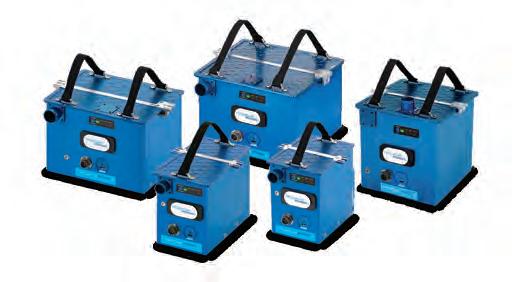
By Matt Thurber
Garmin introduced its third-generation integrated flight deck, G3000 Prime on the eve of NBAA-BACE. The most unique feature of G3000 Prime is that all the displays are now touchscreens, and there are no touchscreen controllers as in the current G3000/ G5000 avionics.
Already approved under FAA technical standard orders, G3000 Prime features 14-inch touchscreen primary displays with more powerful processors, larger screen real estate, and edge-to-edge glass. These replace the traditional primary and multifunction flight displays. Replacing the touchscreen controllers are secondary displays with 40% more display area, and these also can act as standby displays, eliminating the need for separate standbys.
Garmin has updated the user interface in G3000 Prime to deliver an even more intuitive and user-friendly experience. An example of this is linked views, which allows pilots to see how a change in the secondary display affects the flight plan, for example, previewing the various options for an arrival procedure at the destination.
Another key interface change is the adoption of the radial menu from the Garmin Pilot app, which pops up when touching a map view on a primary display. All control features can be accessed on a window in any display, and the displays are designed so a pilot can rest a hand on the display while touching another area, or two pilots can interact with separate windows on one display at the same time.
The G3000 Prime touchscreens are all capacitive touch, which gives users a more positive response. This compares to the G3000/G5000 touchscreen controllers’ infrared touchscreens.

G3000 Prime users will also notice there is no more concentric knob, which has been a Garmin feature for decades. But knobs and buttons are available on the GCU 315 panel, and Prime even can have a rotating selector knob similar to automotive entertainment system applications.
Textron Aviation is the first to announce an aircraft that will feature G3000 Prime, and this will be in the new CJ4 Gen3. Along with G3000 Prime, the CJ4 Gen3 will be equipped with Garmin’s Autoland system, and entry into service is expected in 2026.
G3000 Prime’s user interface is primarily touchcreen displays.
Another technology development by Garmin is its new head-up display (HUD), which is certified in the Textron Aviation Citation Longitude. In the Longitude, the GHD 2100 HUD is matched with an Elbit multi-spectral camera system to provide enhanced flight vision system features, as well as combined vision system overlays of enhanced and synthetic vision syste m imagery.
Garmin is offering the GHD 2100 to other airframe manufacturers that are interested in adding a HUD to their business aircraft. z
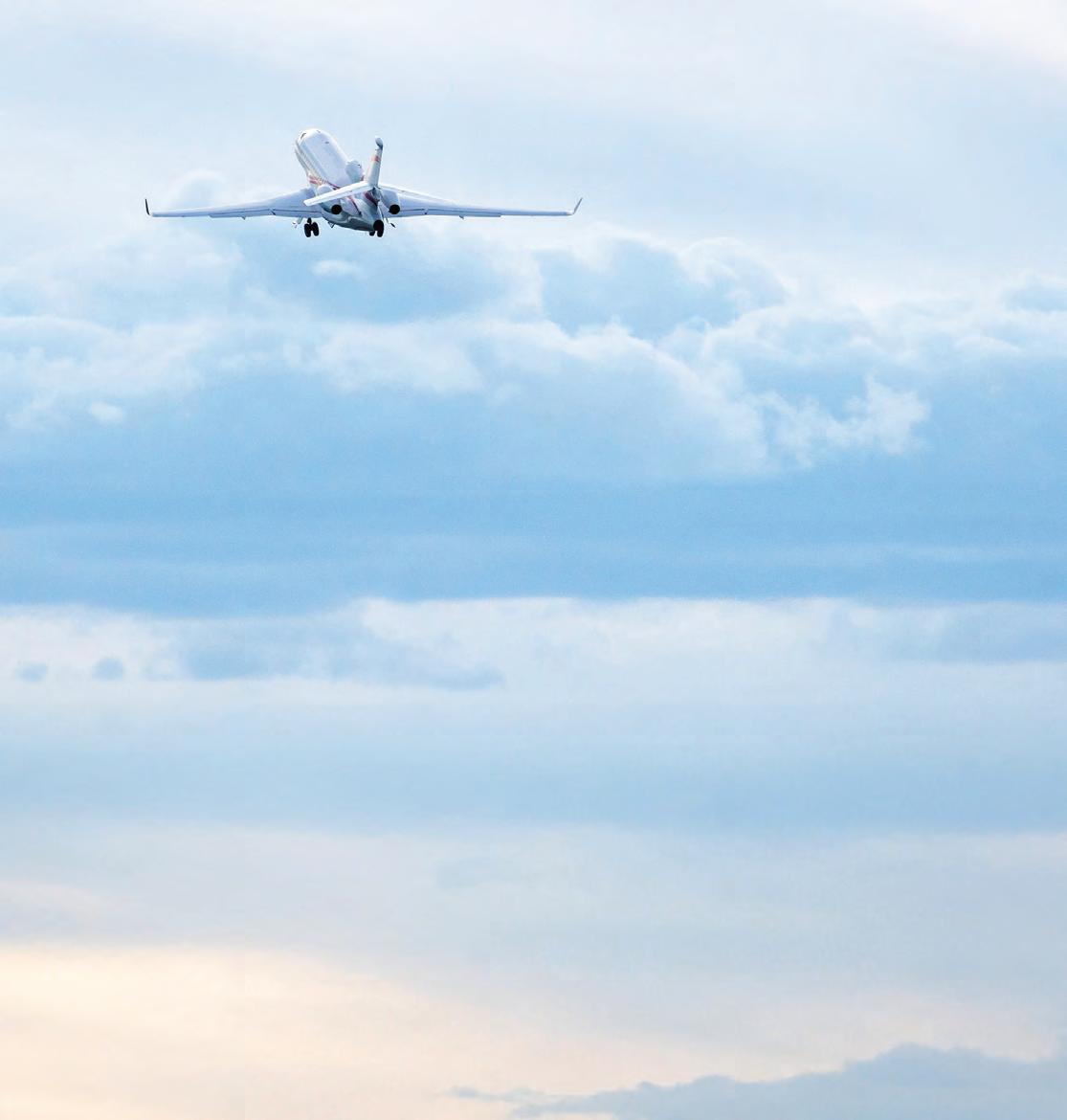

Need assistance managing your carbon portfolio, or just curious about sustainable options like SAF? AvfuelZero has your simple solution. Designed to both streamline and personalize sustainable solutions, AvfuelZero provides the level of support you need to achieve your unique goals—whether that’s a one-time SAF purchase, or a carbon assessment and plan.

by Charles Alcock
For newcomers to chartering aircraft or using fractional ownership programs, the process can seem quite opaque. How are you supposed to know which service providers are well-placed to deliver on their promises and deliver the best value proposition?
Private flight provider Wheels Up has been seeking to introduce greater transparency for its members and customers by sharing more actionable data. These initiatives include a new feature on its app and website that shows travelers real-time dynamic pricing for flights out of specific locations to exploit opportunities to save money with some flexibility over departure times.
The feature was launched in July, showing how different levels of pricing were available at 200 of the most popular city pairs at specific times. Users can select the “Flexible Plans” option to see lower-cost airport pairs that may offer substantial savings per leg.
A members’ portal also tracks savings
achieved for trips and each individual’s status in Wheels Up’s joint loyalty program with its main shareholder, Delta Air Lines. In June, the company simplified its membership and ad hoc charter product offerings.
Wheels Up Membership clients pay an annual fee and make deposits for pre-funded flight hours. These members can earn Delta’s Diamond Medallion status based on how much they spend, and can also use the balance of their funds to pay for commercial flights with the airline, with a 20% fare discount for some routes.
Wheels Up Charter clients don’t pay anything upfront and simply pay as they fly. However, they can earn a 2% flight credit for every $50,000 spent on trips and can also achieve Diamond Medallion status once they reach a qualifying spend amount.
As part of the ongoing effort to return the company to profitability, Wheels Up is paying closer attention to operational performance. It believes it is the only private aviation company, apart from its smaller rival Volato, to publish its operational metrics each quarter in a bid to
be transparent with members and charter customers, but also to focus the minds of its team.
In the second quarter, its completion rate— the percentage of scheduled flights operated and completed, excluding customer-initiated cancellations—was 99%. On-time performance was 87%, as defined by flights that departed within 60 minutes, inclusive of delays resulting from air traffic control, weather and maintenance issues, and customer-related factors.
Early last month, Wheels Up expanded the benefits offered for its Global Custom Enterprise Solutions private flight membership. The changes to the frequent flyers program are available in the U.S. and to clients in other parts of the world, including Europe, where its Air Partner charter brokering group arranges flights through a select group of operators.
The enhanced benefits will be available to new members committing to $500,000 or more in pre-funded flight hours. These include guaranteed availability of a “mission-capable” aircraft with a 48-hour booking and flight cancellation window in the U.S. and 72 hours in Europe. If a trip is disrupted by more than four hours beyond the planned departure time, customers receive a refund and also get a credit toward a subsequent flight.
Members will also now have access to fixed flight-hour rates for a defined range of aircraft that Wheels Up said will make it easier for them to manage travel budgets and make their spending more predictable. z














G3000 ® PRIME IS HERE. OUR NEW THIRD GENERATION FLIGHT DECK WITH EDGE-TO-EDGE GLASS TOUCHSCREEN DISPLAYS, A SLEEK AND INTUITIVE INTERFACE PLUS GROUNDBREAKING AUTOMATION CAPABILITIES. VISIT US AT WEST HALL 1 67 1 FOR A DEMO OR GARMIN.COM/PRIME TO LEARN MORE.
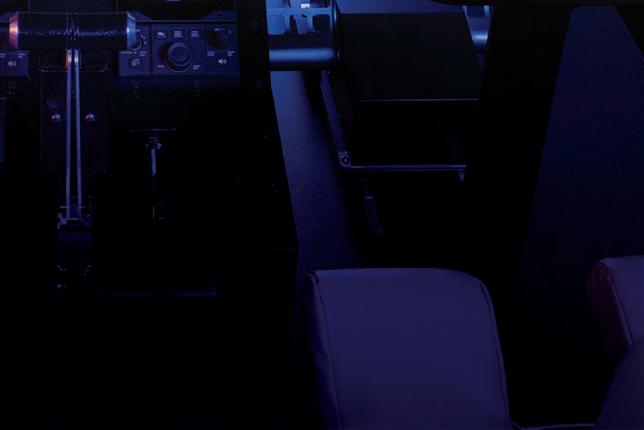

By Curt Epstein
For FBOs and other hangar keepers, new suites of technologies are being developed to help increase safety and logistics. Known as hangar management systems, the functionality of these emerging products ranges from reducing the potential for hangar rash to providing exact aircraft occupancy levels to increase revenue.
One of the newest—Sky View by Georgiabased Fyve By—is wrapping up a year-long beta test program involving 11 hangars operated by FBOs, MROs, and corporate flight departments dealing with “about a quarter billion dollars worth of airplanes,” according to company co-founder and CEO Benjamin Youngstrom.
Sky View uses a proprietary lidar sensor network to track the movement of tow tugs and aircraft in the hangar. The company installs hardwired sensors—the number determined by the size of the hangar—that communicate via an application with the user’s own tablet device, which is mounted on the tow tug near the driver.
The system—on display this week at NBAA-BACE—shows a 3D top-down view of the hangar and its occupants on the tablet and uses lights and sounds to alert the operator when things get too close.
“The idea is to equip crews with a wing walker who never gets distracted, never has a bad night’s sleep,” Youngstrom told AIN. “It’s a wing walker that never stops watching.” He added that the system can also be used
to test fit aircraft in hangars virtually before moving the airplane, identifying it simply by entering the tail number.
Fyve By will charge a one-time installation fee ranging between $15,000 and $25,000, along with a monthly per-hangar subscription fee. Expected to be available on the market at the beginning of next year, the company is working with several insurance providers that are considering offering incentives for the system’s adoption.
A similar product by California-based Hangar Safe uses cameras and artificial intelligence to provide a watchful “eye” on aircraft movements in and out of hangars. Under development for the past six years, the passive system is also always on, with its proximity warning function similar to those on today’s modern
automobiles, alerting tug operators when they encroach on a pre-determined safety zone.
“As they get close, it starts chirping an alarm and flashing lights in the hangar, and then when they get to a final barrier—which we normally set at three feet—it sets off a solid alarm, the lights turn red, and the hangar owner gets an automated email with imagery of what happened,” explained company CEO Ryan Crowl.
Installation involves 10 to 35 ceilingmounted warrantied cameras, depending on the hangar size, along with warning light bars positioned around the hangar.
By design, Hangar Safe does not offer any visual interface for the tug operator. “We specifically didn’t want that because we don’t want line guys looking at tablets and screens when they should be looking at airplanes and walls,” noted Crowl, adding the installation cost for the system starts at $2,500—plus the monthly subscription fee.
Another newly launched hangar management system is Hangar IT by private aviation industry consultancy FBO Partners. According to the company, Hangar IT is the first purpose-built platform designed to store, manage, and optimize revenue from aviation lease and sublease agreements such as hangar space and offices. It can also provide on-demand hangar occupancy reports, allowing service providers to increase revenues from transient aircraft storage.

Through integration with JetNet’s database, Hangar IT can also accurately identify and verify turbine aircraft by registration, serial number, and type. By using the platform’s roll call feature, it can capture and record all movements of tenant and transient aircraft to provide an accurate inventory of available hangar space.
The system’s lease forecasting tool will o ff er added insight on the revenue side by monitoring lease renewal rates, identifying vacancies, and providing an overall view of the facility’s real estate portfolio.
Our mission is simple: to transform a potentially complicated and timeconsuming transaction into a seamless, customized financing solution that meets your unique needs. Our decades of experience provide an unmatched level of expertise—and the ability to craft solutions for virtually any challenge— with speed and confidence. And our global footprint gives you access to onthe-ground expertise wherever you’re operating.
So, bring us your challenges. And we’ll show you the art of what’s possible.
844.436.8200 \ info@globaljetcapital.com globaljetcapital.com
Companies including Surf Air Mobility have signed up to operate

by Charles Alcock
Imagine if you could move the boundaries of private aviation lift beyond where current fixed-wing aircraft and helicopters can operate. Also imagine if direct carbon emissions from flights could be significantly reduced or virtually eliminated.
That’s what distributed electric propulsion is expected to make possible, and three prime examples can be found this week at NBAABACE in the shape of eVTOL vehicles being developed by Joby Aviation and Lilium as well as a hybrid-electric STOL design from Electra.
According to California-based Joby, it is on track to complete type certification with its still-unnamed four-passenger eVTOL model by year-end. That should allow for first deliveries and the launch of commercial air taxi services in some cities from the start of next year. The lift-and-cruise design features six tilting electric motor/rotor units installed along the wing and a V-shaped tail.
Joby already holds a Part 135 charter certificate and plans to be the operator of early use cases for the all-electric aircraft on routes of
up to around 87 nm. It has developed its own ElevateOS suite of software tools to support commercial operators and expects to recruit both military and civil pilots.
However, the company has also signed up customers/partners such as Delta Air Lines, which will be involved in operating shuttle services such as those planned between Manhattan and JFK International Airport. Joby has already scoped out a heliport in Kearny, New Jersey, as its base for New York City-area operations.
Meanwhile, Textron eAviation is openly working on an eVTOL design. The Textron division is now building the first full-scale example of its Nexus eVTOL in Wichita, with support from the group’s Bell helicopters subsidiary and its Slovenia-based electric aviation specialist Pipistrel.
Lilium’s design is notably different; its Lilium Jet features 30 tilting ducted-fan electric engines installed in the wing and canard. The aircraft, which is expected to enter service in 2026, is being offered in a four-seat Pioneer Edition version for business and private aviation customers. A standard six-passenger
version will be used for regional air services.
The German company already has sales agreements with several business aviation companies. Texas-based EMC Jet has agreed to be its exclusive private sales dealer in the U.S. through 2030. In the UK, Volare Aviation is set to take up to 20 of the aircraft and will operate these on behalf of individual owners and also for charter flights.
Virginia-based Electra was not willing to settle for the range and payload limitations of current battery-powered eVTOL aircraft. Instead, it is working on a hybrid-electric STOL aircraft that it said will be able to serve regional routes of up to around 435 nm and fly at speeds up to 174 knots.
Critically, Electra intends for the yetunnamed model to be able to operate from landing strips of no more than 300 feet in length. The company maintains that this will open up commercial air services in all sorts of new urban and suburban spaces, bypassing existing airports. The company has coined the term “ultra short” for this performance.
Electra is flight-testing a two-seat technology demonstrator and expects to fly a full-scale prototype in 2026. It is targeting FAA type certification under FAA Part 23 regulations in 2028.
Operators such as Surf Air Mobility and Bristow have signed provisional order agreements with Electra. The company is expected to unveil its first full-scale prototype at an event next month.
Experience the perfect supplement to your existing fleet with a world-class experience for your crew and passengers with onboard Wi-Fi and award-winning safety systems. With best inclass fuel performance at less than 70 gallons per hour in cruise, the Vision Jet is unmatched in regional mission performance.
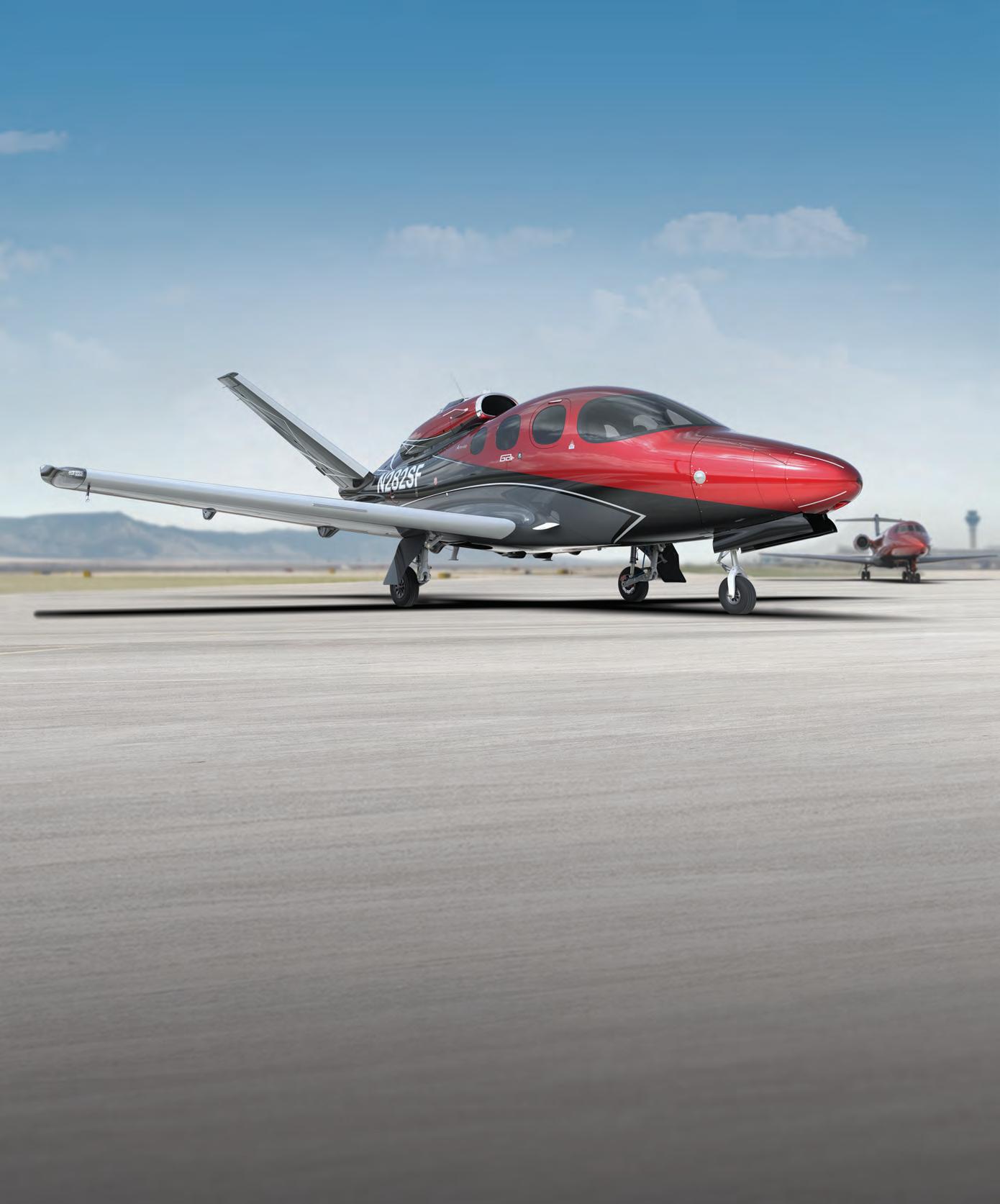

The all-composite Nexus eVTOL will be able to carry four passengers and a pilot on 60-mile flights. Service entry is planned for the 2030s.

By Matt Thurber
In a building called the Glass House next to McConnell Air Force Base in Wichita, Textron’s eAviation division is forging ahead with construction of the first Nexus eVTOL aircraft. The 35-foot-long backbone of the wing—one of the largest composite parts the company has ever made—is being assembled on a jig and the fuselage unveiled earlier this year is taking further shape although separately from the wing.
Textron eAviation is leveraging the skills of experts at its sister companies to build not only the first Nexus but also the infrastructure needed to support the program. This includes Textron Aviation and its McCauley Propeller subsidiary, as well as parent Textron’s Bell and eAviation’s Pipistrel division, along with various internal resources and machinery. For example, the autoclave in which the airframe’s composite parts are cured was originally installed for the Beech Starship airframe and Premier 1/1A and Hawker 4000 composite fuselages.
Pipistrel is contributing batteries, battery management systems, and charging technology that will use the CCS1 (Combined
Charging System 1) protocol for the U.S. and CCS2 in Europe.
The program is also tapping Bell’s expertise in tiltrotor design and fly-by-wire flight controls. Now Nexus is bringing all these together to create an electric flying machine that could pave the way to an era of sustainable flight.
It is only when seeing the hardware that one appreciates how big the Nexus is; its footprint extends to about 50 feet fore and aft and side to side. This is no small lightweight aircraft, and it will take a considerable amount of power to loft it vertically into the air—namely 2,000 pounds of liquid-cooled batteries mounted inside the wings. (The Pipistrel Velis Electro uses liquid cooling for its in-house-developed battery system.)
These batteries will power four forwardtilting motors fitted with McCauley four-blade propellers—one on each wingtip as well as two tilting motors mounted on the forward end of a boom on either side of the cabin. Two other electric propulsion units oriented for lift balance out the back of each boom, and these aft proprotors are Bell designs, for a total of six propulsion units.
Each McCauley propeller is about 12 feet in diameter, the largest ever built by the
company and the same diameter as the Bell proprotors. The booms are joined in the rear by the V-shaped empennage, which is designed to minimize vibration, according to JD Terry, Textron eAviation’s director of engineering.
While the fuselage employs carbon fiber as a composite outer skin, some aluminum bulkheads are used where appropriate. Textron eAviation isn’t using the fiber-placement machines that wound material onto a metal form to manufacture Premier and Hawker 4000 composite fuselages.
The wing is all-composite and will extend to about 50 feet once the tilting propulsion units are installed. Wichita State University’s National Institute for Aviation Research (NIAR) assisted with construction of the wing.
With Textron Aviation’s longtime reputation for conservative yet practical aircraft design, it’s no surprise that entry into service of the Nexus isn’t scheduled in the near term. “I think we’re very pragmatic about this space,” said Textron eAviation president and CEO Kriya Shortt. “Our plan for entry into service would be in the 2030s, which we think is the culmination of technology, of the regulatory environment, and of the market itself.”
Capable of carrying four passengers and one pilot up to 60 miles with the current battery system, Nexus will—like all of Textron Aviation’s products—be available for whatever use case the customer desires. This could be an air taxi business model, air ambulance, or for special missions and military uses, Shortt acknowledged. The cabin interior has more cabin volume than a Cessna
The unmistakable feeling of being more than a tail number.

At Atlantic Aviation, you’re not just another number. You’re important to us, and our team is determined to ensure every visit is a standout experience. From approach to departure, we reach beyond the ordinary. Every aspect is handled with care—
a friendly welcome, unexpected attention to detail, modern sustainable facilities, thoughtful amenities—plus, a touch of fun. So, prepare for a visit where you’re treated like the VIP you are. It’s our pleasure to be of service.
T206 single-engine airplane, according to Terry, although the overall airframe footprint is larger.
“We want to have a vehicle that is multimission-capable, that answers the needs of our customer base,” said Shortt. “One hundred plus years of experience across the Textron business units in the aerospace sector gives us the opportunity to make sure that the product is going to have broad appeal, which we think is what our customers expect from products that are designed and manufactured by Textron.”
NIAR is also hosting the ground test facility for Nexus. Planned to be operational by the end of this year, the facility includes a control station and a ramped structure on which Nexus will be restrained during testing of its propulsion systems.
“It’s funded by the state of Kansas to help strengthen aviation industry technologies” under the Kansas Aviation Research and Testing Growth Initiative, explained Andi Meyer, manager of engineering. “It’s going to allow us to test the aircraft in a fully restrained manner, so it’s a controlled environment. We can assess how that aircraft behaves, what the performance is like, what the thrust characteristics are like, all from the safety of not leaving the ground. We’ll be able to test everything we need to test before we go to flight test, so it’s a really important milestone on our path to certification and on our path to flight testing.”
The 15-foot-high, 20-foot-wide elevated ramp’s design has a specific purpose: to allow testing high enough to eliminate the influence of ground effect, which amplifies lift when a wing is near the ground. Data from the aircraft and load cells built into the ramp will be sent to a mission control station on the NIAR grounds. “We’ll be able to watch all of this testing occur from very nearby,” she said.
Housed in a moveable trailer, the ground control station will also be used for remote piloting during flight testing. The trailer has two levels, one with equipment and workstations, then a stairway leads up to a piloting platform with large windows where test pilots can view the action. Being mobile, the trailer will travel with Nexus when remote operations are underway.
Bell, Textron Aviation, and Textron Systems contributed to the telemetry and triple-redundant radio datalink equipment, as well as live video feed. Each datalink operates on different frequency bands, Meyer explained, “so that we have high-integrity communications with the vehicle. It also has redundant inputs for AC power, as well as backup battery power for the AC power and the low voltage that powers avionics equipment.”
Once sent to the trailer, data is fed to workstations in the trailer and elsewhere to engineers monitoring the flight-test activity. “This is like an order of magnitude more complicated than earlier [telemetry systems],” she said.

While Shortt couldn’t offer a timeline for the first untethered flight of the Nexus, she did say that the first contained tethered flight is scheduled for the second half of 2025. “Once we have satisfied ourselves there, [then] we’ll move to the remotely piloted flight, which is the step process. Stay tuned.”
Unlike Textron eAviation’s Pipistrel Velis Electro, which is a conventional airplane powered by a battery-driven electric motor, the Nexus will have fly-by-wire flight controls and envelope protection features that will keep pilots out of trouble. This is similar to the unified flight control concept that other advanced air mobility designers have adopted.
In the Nexus simulator, there are two hand controls and no pedals (what looks like pedals are just a resting place for the pilot’s feet). I gave the simulator a try during our pre-NBAABACE visit.
The right stick or inceptor moves the aircraft in three axes. From a hover position, pushing forward or aft, right or left, moves the Nexus in the direction of inceptor movement, while maintaining the hover altitude and level attitude. Twisting the inceptor induces yaw left or right.
“This is the hover mode,” said Terry, “and our control laws and our software are pretty mature in the hover mode. It flies pretty much like you’d expect, like a highly augmented drone.”


We were meant to fly.
Once you’ve flown to where you want Nexus to be, just remove your hands from the inceptors, he explained, “and it’s going to go and latch onto your position and altitude. The idea is it’s really easy to fly as a pilot, so if there’s wind or disturbances, the control laws will handle that. You just tell it where to go, and the control laws handle the rest.”
To change altitude, I just move the left inceptor forward to climb or aft to descend (straight up or down). “If you leave the stick in the detent or don’t touch it, it’ll hold your altitude as you make all your other changes,” Terry said.
When I pointed out that it seemed unintuitive to have the vehicle climb with a forward push of the left inceptor, he explained that a video game grip is used on the left side. This will be replaced by a thrust-lever-style grip, which will respond to a push by increasing thrust. But this all has to be integrated with what’s going on with the propulsion units, with the two forward and two wingtip propulsion units able to convert from vertical to forward lift.
“The control law is pretty mature,” Terry said. “In hover, we can do the conversion and go to forward flight…but we intend to make it a lot easier to fly as we keep working o n it.”
To enter the conversion mode in the current setup, I pushed full forward on the right inceptor and the Nexus maxed out at 20 knots. After moving a small switch on the inceptor to engage the conversion, I couldthen let go of the inceptor. A display showed the position of the forward and wingtip nacelles as they shifted from vertical to horizontal, while I managed pitch guidance on the primary display that guided me “through the conversion corridor,” as he explained it.
Now Nexus was flying in a more traditional airplane mode, and pulling aft or pushing forward on the right inceptor induced pitch changes while left and right moves induced bank. Turn coordination is automatic so there was no need to twist to induce yaw, and Nexus automatically compensates for lift changes during the turn so I didn’t have to pull the inceptor aft while in a turn as I would in a normal airplane.

“Eventually we intend to add additional loops on top of this,” he said, “so it’ll be extra augmentation. The idea is it’s going to be really easy. A lot of that manual flying that you normally have to do as a pilot is handled by the control laws, and so the pilot can focus on [what’s necessary].”
To convert back to hover mode, I pulled the thrust offset back to 20% power then toggled the inceptor switch and let go of the controls, and the simulated Nexus settled back into a hover. “That’s been the focus of the control law development—for hover—since our first testing is going to be on the hover,” Terry said.
There is much more to Textron eAviation than the Nexus eVTOL. Pipistrel, for example, has more than 2,500 airplanes in service, including light sport and ASTM-qualified training airplanes such as the Velis Electro, which is now FAA-approved for sale in the U.S., and the high-performance piston-powered Panthera.
A retractable landing gear single-engine airplane, the speedy Panthera should achieve
EASA CS-23 certification in the second half of 2025, and plans call for simultaneous FAA validation. “It’ll go 15% further, 10 knots faster, and burn 30% less fuel than its closest competitors,” said Shortt.
Pipistrel’s engineers are also developing the hybrid Nuuva V300 uncrewed aircraft, which will take off and land vertically under electric power and then fly horizontally powered by a Rotax piston engine. Capable of carrying 700 pounds of cargo about 300 nm, the Nuuva features fly-bywire flight controls, but it will be operated by a ground-based pilot.Eventually, one operator will be able to manage multiple Nuuvas, and the goal is to achieve autonomous operations.
“We see this being an air vehicle that can be used both for disaster relief, where maybe you were unable to get people into a space because of infrastructure, but with its electric vertical takeoff and lift capability, you could deploy a Nuuva,” she said. “[You could] have it be unloaded by people who are on the ground and then return it back for additional provisioning. We see it being very capable for the armed forces and forward deployment of provisions as well as commercial opportunities.”
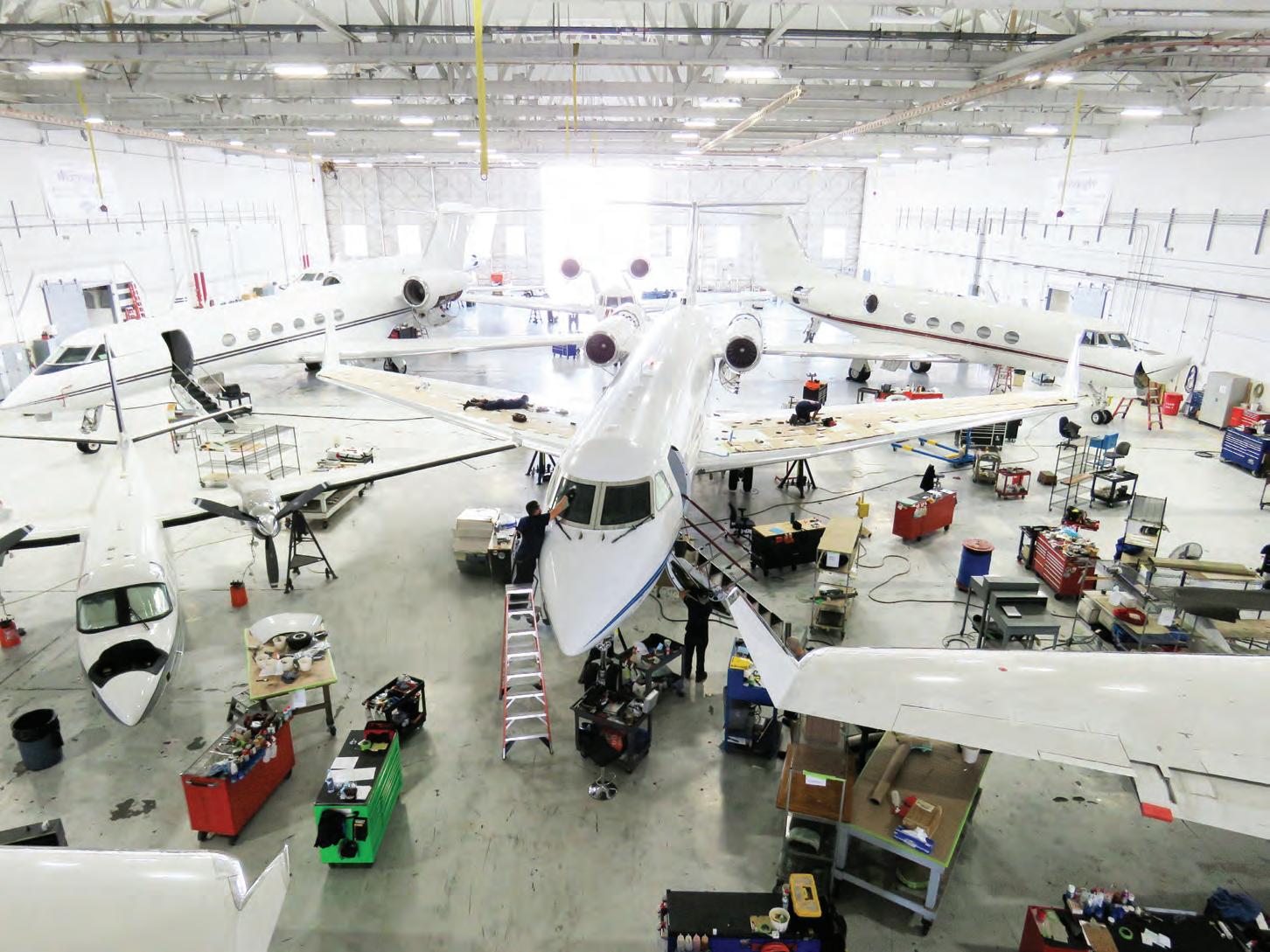
LEARN MORE OR VISIT US AT BOOTH #2373!

By Amy Wilder
Speaking on the eve of the 2024 NBAA-BACE, Daher Aircraft CEO Nicolas Chabbert championed the company’s recent hurricane relief efforts and discussed updates to the company’s turboprop lines, as well as the Me & My TBM app.
Chabbert noted Daher worked alongside private Kodiak and TBM owners to ferry vital supplies and rescue animals in the aftermath of Hurricane Helene and Hurricane Milton. Daher also provided on-site repair services for a U.S. Forest Service Kodiak 100 in North Carolina as part of the relief efforts after a jet blast damaged the aircraft.
For Daher, this kind of assistance is an ongoing effort. Chabbert pointed to the company’s recently announced partnership with the Recreational Aviation Foundation to provide transportation support.“We are now on our second year to provide support to RAF,” Chabbert said, adding that the company will continue to provide long-term aid to the U.S. Forest Service and RAF.
Meanwhile, he announced the latest upgrade for the Kodiak 100, integrating Hartzell Propeller’s five-blade composite propeller with a pitch latch function for water operations on floats. The new pitch latch function enables float-equipped Kodiaks to maneuver more easily on water with greater control, the company stated.
In addition, the upgraded prop can be retrofitted on in-service Kodiak 100s through the Hartzell Top Prop program. The enhancement comes as Daher commemorates the 20th anniversary of the Kodiak 100’s first flight, which took place on Oct. 16, 2004.
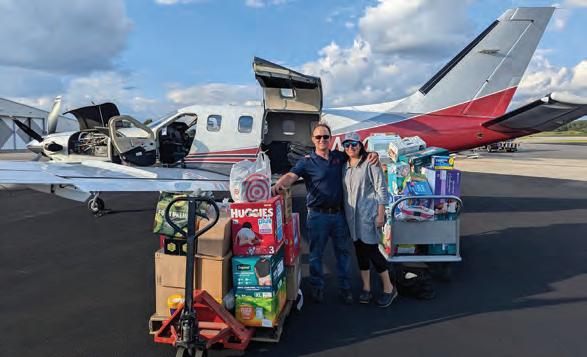
Chabbert noted that the TBM 960, now in its third year of production, continues to undergo improvements. The aircraft’s e-copilot enhancements include “Home Safe,” an emergency autoland program triggered after 30 minutes of pilot inactivity, as well as alert messages for pilots and taxi information enhanced by 3D visuals.
Having those alert messages “tremendously changes safety in the cockpit,” said Chabbert. He added that audio alerts help to improve pilot reaction time. Other recent safety updates to the TBM 960 include high-intensity LED nosegear taxi and landing lights.
Moving into the technology side of the business, Chabbert unveiled Version 7 of its Me &
Daher worked with Kodiak and TBM owners to ferry supplies and rescue animals in the aftermath of Hurricane Helene and Hurricane Milton.
My TBM cloud-based pilot app, highlighting changes that include integrated document management and real-time support for TBM owners and operators. The app now features centralized documentation updates with realtime syncing. Chabbert noted that the app has more than 400 active users per month, “a third of the fleet.”
Last year at NBAA-BACE, Daher CEO Didier Kayat said trials of the EcoPulse hybrid propulsion technology were imminent. Chabbert did not have updates on the project but hinted that news is coming in December. “We are about to finalize the report after the test campaign,” he said. z
By Curt Epstein
“Uncertainty is the number one word that we see,” said Rolland Vincent, JetNet iQ survey founder and the head of Rolland Vincent Associates, while describing the current industry sentiment. “We see it all over our data— what’s going on? What’s going to happen?”
Speaking on Monday morning on press day at NBAA-BACE, Vincent detailed the results of the latest JetNet iQ quarterly survey, which is in its 14th year. From its recently closed Q3 survey, the industry’s net optimism score is the lowest since the start of the Covid pandemic
in Q2 2020, with North America leading the plunge. “People are very confused,” said Vincent. “Uncertainty is profound right now.”
Among the major factors is angst over the looming U.S. presidential election, now less than a month away. Based on the survey’s historical data, uncertainty was seen in Q3 in the past two election years but rebounded after the election results were certified.
Another source of indecision is the several ongoing geopolitical conflicts that threaten to expand. Vincent soundly rejected the suggestion that the U.S. economy is doing poorly.
continues on page 70
www.amacaerospace.com

By Curt Epstein
To demonstrate its commitment to sustainability, Pilatus Aircraft is partnering with Austriabased cabin materials manufacturer F/List on the display of a PC-24 cabin mockup designed with environmentally friendly materials.
On exhibit this week at NBAA-BACE, the mockup marks the debut of F/List’s plantbased oil wood veneer finish, which minimizes the release of harmful volatile organic compounds into the environment while enhancing the appearance of the wood. It is engineered for durability and scratch resistance, requiring minimal maintenance.
The eco-friendly demonstrator enables the Swiss airframer to highlight the next generation of sustainable interior materials available for its jet interiors to show attendees. Its furnishings highlight a variety of F/List products such as wood veneers, engineered Linfinium countertop derived from plant oil and marble fragments, F/Lab Aenigma bulkhead created from recycled stone dust, synthetic “Whisper” leather lower side panel, and Fresco Décor upper side panel.

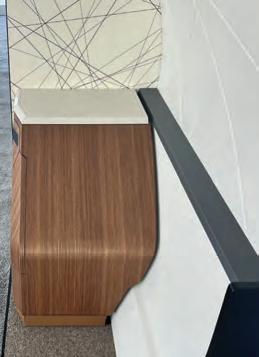
“We are excited to showcase how the F/ LAB materials harmonize to bring sustainability, style, and sophistication into the cabin,” stated F/List CEO Katharina List-Nagl. “The PC-24…mockup exemplifies the original thinking, manufacturing excellence, and innovative spirit of both companies at a time when sustainability is more important than ever.”
Pilatus noted that most of the fabrics it uses in its interiors are recyclable, made from special fibers rendering them easy to clean, requiring less water and detergent. Its carpeting is
DPI is showing o its latest innovations this week at NBAA-BACE, including what it says is the first-ever “aviationized” Apple TV and an “app-less” NFC cabin control system.
The Apple TV, which the company is unveiling for the first time at NBAA-BACE, has been flying on an Airbus A319 this year.
DPI said the “aviation version” of the Apple TV has the same features as the consumer version, including being able to use Airplay with devices, access to personal content libraries, and Dolby technology.
The system also works in tandem with DPI’s server, which allows retrieval and playback of stored digital content onboard, and it supports streaming when paired with
high-speed internet services like Starlink.
“At DPI Labs, we’re committed to bridging the gap between consumer technology and aviation, making the passenger experience as seamless and enjoyable as possible,” said Martin Hamilton, DPI’s vice president of sales.
“With aviationized Apple TV, we’re excited to bring the convenience and entertainment that customers enjoy at home into the skies, all while maintaining the rigorous standards and reliability required for aviation use.”
The new cabin control system allows passengers to use a smartphone or tablet to manage things like lighting, entertainment, and audio/ visual settings on board by tapping an NFC chip, which opens an intranet site on their devices.
F/List, an Austrian manufacturer of cabin materials, is debuting its plant-based oil wood veneer finish in a Pilatus PC-24 cabin mockup at NBAA-BACE.
produced from natural wool—a renewable and biodegradable material—offered in a collection with no artificial dyes for the airframer’s most environmentally aware clients.
“We make every effort to constantly improve what we offer our customers, and we strive to reduce our environmental footprint without compromising on quality or performance,” explained André Zimmermann, the OEM’s v-p of business aviation. “Pilatus has been committed to sustainability and energy efficiency for many years, in our production processes, for example.” z

DPI’s “aviationized” Apple TV
NFC tech is known best for allowing for contactless payments and wireless data sharing.
“We’re proud to be the first to introduce NFC technology to the business aviation market,” said Hamilton. S.R.

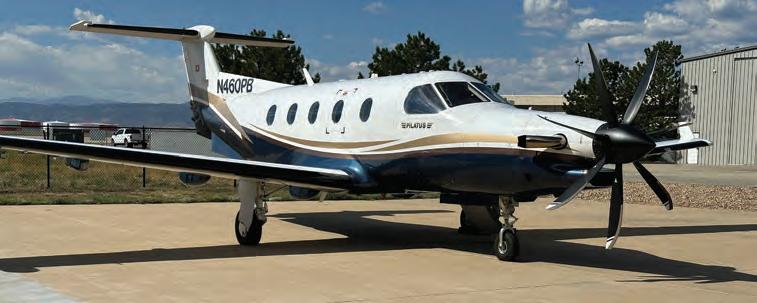
The Finnoff Elite Performance package includes a seven-blade composite propeller.
By Matt Thurber
Finnoff Aviation Products has combined upgrades for the Pilatus PC-12 into a single offering called the Elite Performance Package, which includes a new engine, propeller, electrical bus tie, and various battery options. The bundle saves buyers about $100,000, equivalent to the price of the propeller, according to Finnoff.
Available for the pre-2008 PC-12/45 and /47 models, the Finnoff package starts with replacing the original Pratt & Whitney Canada PT6A67B engine in legacy PC-12s with the PC-12 NG’s PT6A-67P.
While both engines produce 1,200 shp for takeoff, the -67B’s maximum continuous power is limited to 5 minutes, then power is limited to 1,000 shp. The -67P is fitted with power turbine blades made of a super-nickel alloy that is more resistant to creep and higher heat levels, and it can run at an interstage turbine temperature (ITT) of 820 degrees C. The -67P is limited to 780 degrees for 5 minutes, then it must be reduced to 760 degrees. The result for the modified PC-12 is faster climb rates and cruise speeds.
The engine upgrade costs about $1.9 million and includes a five-year, 2,500-hour warranty, plus free Eagle Service Plan membership.
Typical overhauls cost $1.2 to $1.5 million, according to Finnoff, and some can be as high as $1.85 million. When an upgraded legacy PC-12 with the new engine goes on the market, the extra cost of the upgrade is generally recouped,
the company said. Swapping the engine in the PC-12 takes about 250 to 300 hours of work.
The upgrade package’s seven-blade MT composite propeller reduces vibration, lowers noise levels by 4 to 6 dB(A) and cabin noise by 6 to 7 dB(A), and improves climb performance, even without the engine upgrade. Finnoff flight testing documented a reduced takeoff ground roll. With the seven-blade propeller alone, ground roll is 10% lower, and takeoff distance over a 50-foot obstacle is reduced by 15%, although actual performance is better than the conservative numbers published in the manual.
Compared to the five-blade MT propeller, the seven-blade is slightly less than 3 inches smaller in diameter. The many blades still could interfere with a tow bar, so Finnoff designed a special tow bar adapter that slides underneath the blades and eliminates any interference.
With more blades, the new propeller has a smaller diameter, providing more ground clearance and FOD protection. Installing it requires no changes required to the engine or governor. Individual blades can be replaced. Field repairs are also possible, and a damaged area on a blade can be fixed with an epoxy repair.
The electrical bus tie upgrade solves a limitation on the legacy PC-12s, which are equipped with two generators, one 300-amp and the other 115-amp. The existing bus tie is limited to 115 amps, and failure of the primary generator thus requires shedding electrical load to match the bus tie limitation. With the new engine
installed and a 300-amp backup generator or a Finnoff upgrade to install the larger backup, the bus tie upgrade matches the PC-12 NG’s 220-amp limit, allowing the backup generator to carry much larger loads.
Battery options with the Elite package include dual lead-acid Concorde or single or dual True Blue Power TB-40 lithium-ion batteries. The advantages of the TB-40 batteries are their lighter weight and longer life, with no maintenance required for seven years.
To see the performance change to a legacy PC-12, Richard Phelan—chief pilot of Finnoff Aviation sister company Avex—demonstrated the difference in the company’s converted legacy PC-12. With four people on board and 2,700 pounds of fuel, the PC-12 weighed about 10,400 pounds, slightly below mtow.
We took off from Rocky Mountain Metro (KBJC) near Denver, climbed to 14,000 feet, and aligned so winds were perpendicular to our flight path. Continuing the climb through 16,000 feet, I timed how long it took to climb to FL280 with power set to the 760-degree maximum ITT to simulate the legacy PC-12. Total time for the climb was 14 minutes 30 seconds.
Outside air temperature was ISA plus 12 degrees. While level, we did some speed checks, and at the same simulated maximum power setting, true airspeed settled at 243 knots, with fuel burn 330 pph.
Phelan then pushed the power to 820 degrees ITT, the maximum continuous for the new engine, and fuel burn climbed to 370 pph while true airspeed notched up to 264 knots. He pointed out that Pilatus pilots don’t typically fly at maximum power, preferring to trade longer engine life and lower fuel burn for reduced speed.
We ran the same test after descending to FL220. With power set to 760 degrees, true airspeed was 247 knots and fuel burn 380 pph. At 820 degrees ITT, true airspeed climbed to 273 knots and fuel burn was 420 pph.
Back at 14,000 feet, we returned to a climb attitude, and I restarted the timer passing through 16,000 feet, with power set to 820 degrees ITT. This time, the climb took 10 minutes 50 seconds.
Phelan pointed out a key benefit of the more powerful PT6: faster climbs through ice-laden clouds, which is helpful in the Denver area. z

By Curt Epstein
Textron Aviation’s machinist union members have agreed to a new contract and will end the labor strike that began on September 23 at its Wichita facilities.
The International Association of Machinists and Aerospace (IAM) Workers District 70, Local Lodge 774 ratified the new five-year agreement on Sunday. The OEM is now working to welcome back its employees who have been on strike, starting on Wednesday.
“We are pleased to have ratified a contract with the IAM that offers our employees, their families, and the Wichita community a shared future,” said Textron Aviation president and
CEO Ron Draper. “We value our workforce and the work they do, and this agreement reflects our commitment to our team. The ratification of this contract marks a new chapter, and we are eager to move forward together.”
Among the key points of the new labor agreement are maintaining major manufacturing operations in Wichita, a 31% salary increase over the five-year life of the contract with an immediate 11% increase upon ratification; cost-of-living adjustments of up to $1,500 a year; a guaranteed $3,000 annual lump sum payment per employee; an updated pay scale for long-tenured employees; and an increase of the company match to 9% in its 401(k) savings plan.
In addition, the agreement caps insurance plan premium increases for its low- and high-deductible health care plans. It ensures no insurance premium increases through 2029 for its no-deductible health plan with free services at its Plane Healthy Wellness Centers and pharmacies including primary care visits, preventive care, mental health care, health coaching, physical therapy, labs, and X-rays.
About 5,000 IAM members went on strike after rejecting Textron’s previous proposal. Members voted down that contract by 81%. Strikers represented workers at Textron Aviation’s east and west campuses, as well as its service center in Wichita and component manufacturing locations. z
Preowned business aircraft transactions remain on the upswing, increasing by 24% through the first three quarters of the year for accredited International Aircraft Dealers Association (IADA) members, according to the organization.
Releasing its third-quarter 2024 preowned aircraft market report on Monday in Las Vegas at the NBAA’s 2024 edition of BACE, IADA reported 874 business aircraft transactions were under contract through the first three quarters, compared with 704 in the same period in 2023.
For the third quarter, IADA dealers closed 373 business aircraft deals, compared with 324 in the same period in 2023 and 331 in the third quarter of 2022. Year-to-date, closings reached 993 by the end of the third quarter, up from 868 in 2023 and 929 in 2022.
“While the summer months may have been a bit light on sentiment toward business aircraft transactions, which is a seasonal norm, most of the dealers and brokers are reporting heightened activity over the past month,” said IADA chair Phil Winters, vice president of aircraft sales and charter management for Greenwich AeroGroup and Western Aircraft. There were 965 aircraft retained to sell exclusively with IADA dealers, which is 50% up from 642 at the end of the third quarter in 2023.

How long an aircraft stays on the market has been a focus in the industry. According to Amstat data, the “days on market” rate increased by 55% over the past 18 months. The trend has stabilized in the third quarter, with the days-on-market rate experiencing only an 8% increase, staying below the 10-year average. S.R.










































By Sarah Rose
Basel, Switzerland-based FBO, MRO, and completions firm Jet Aviation is aiming to set the standard with its innovative approach to cabin design and pioneering advancements in acoustic technology, according to Christoph Fondalinski, the company’s v-p of completions.
A point of focus on the latter is Jet Aviation’s “Innovation Space”—a simulated showroom that allows customers to experience how the company’s acoustic treatments and other features respond to cabin noise environments in flight.
“One of our real differentiators in the market is the acoustics, how to make the cabin as quiet as possible, and at the same time making sure that the weight of the interior is in line with the customer needs to operate the aircraft,” Fondalinski told AIN. “So when we decided to create the Innovation Space, it was the idea of, ‘How can we present to the customer certain acoustic values of the interior to make sure that the customer can select the right materials, the right treatment needed and to achieve this target of noise in the cabin?’’
We really want to be pioneers in the industry, and we’ve done more than 400 completions...
—Christoph Fondalinski Jet Aviation v-p of completions
He added that effort comes from customers hoping to make acoustics a factor in their design concepts. “They want to make sure that the aircraft is quiet so that when they walk through the aircraft, when they sit down, they

can communicate, they can watch movies, whatever is required,” he said.
The materials that come with design also play a role, as well. “So we listen to the customer needs of how they would like to lay out the interior. What kind of materials, the color scheme, the materials they would like to use based on their taste,” he said.
“But a very strong focus is on the performance, of course, and then also on technology and internet and staying connected all the time.”
Fondalinski said the company has decades of experience outfitting green aircraft with bespoke VIP cabins.“We launched the first VIP completions project in 1977 at the Paris Air Show,” he noted.
“We really want to be pioneers in the industry and we’ve done more than 400 completions. We’re really focusing on what we call narrowbody and widebody green aircraft completions here in Basel. But with our capabilities in-house, we also do refurbishment and upgrades on in-service aircraft here in our facility.”
Fondalinski said that the company handles all of its green interior work in-house. “We have our own engineering department which is then effectively doing all the detailed
engineering activities from the cabinetry, but also all the system-related avionics and mechanical system installations,” he said.
“And then we have our production facility that we just opened three years ago here in Basel, which is capable to produce all the interiors for the bespoke cabins that we can produce.”
That work also extends to its sister company, Gulfstream Aerospace, with which Fondalinski said Jet Aviation has been in a collaborative relationship that has extended for more than 10 years. Both companies are owned by parent company General Dynamics.
“On Gulfstream aircraft, we collaborate a lot on the technical approach and how to make the cabin lighter, but we are also a service center for Gulfstream,” he said. “We do line maintenance, refurbishments, and upgrades. We can not only do that here in Basel but in our other facilities around the globe.”
Jet Aviation Basel has six hangars and can accommodate aircraft up to the Boeing 747 for completions, refurbishment, and maintenance. In 2021, an 8,000-sq-ft completion center was opened, bringing the cabinet shop, interiors and finishing shops, and sheet metal shops together in one location. z

By Charles Alcock
NBAA has added to the ranks of its Leadership Council, which consists of executives from more than 140 member companies. At the 2024 BACE show, the industry association is welcoming the following five companies: aircraft sales broker JetAviva, Concorde Battery Corporation, software specialist Web Manuals, business aviation services group Clay Lacy Aviation, and FBO operator Million Air.
According to NBAA, the Leadership Council’s advocacy role has become more critical as the industry faces criticism over issues such as the environmental impact of aviation and social justice. Its members have articulated the industry’s role as a generator of innovation, sustainability, and opportunities for future aviation professionals. They collaborate with the association’s government affairs team through campaigns such as No Plane No Gain and Climbing Fast.
“The need to demonstrate the vital role business aviation plays for citizens, companies, and communities across the U.S. is critical if we want to see our industry continue to
thrive—or exist,” Lyndse Costabile, executive liaison for the Leadership Council told AIN “The group’s simple yet bold mandate initially is to support the association’s work to shape the industry’s destiny.”
Since its inception in 2009, the Leadership Council has played a role in defeating air traffic control privatization, preserving access to airports and airspace, and upholding protections for the privacy of those using business aircraft. It has also supported representation of industry positions before international aviation bodies, as well as growing the business aviation workforce, and enhancing diversity across the industry.
At this week’s BACE show in Las Vegas, multiple Leadership Council companies are exhibiting. Executives designated by those companies are participating in NBAA’s new Flight Deck panel-and-discussion series.
Throughout the year, member companies are also involved in youth and community outreach events around STEM and aviation education. Companies support business aviation days and invest in their own young professionals engaged with NBAA’s YoPro programs. z

NBAA president Ed Bolen meets with the NBAA Leadership Council, which plays a critical role in industry advocacy.
Duncan Aviation’s senior avion ics sales representative, Jus tin Vena, is leading a session on the evolving landscape of business aviation con nectivity at NBAA-BACE this week. Titled “The Future of Connectivity,” the session will take place on Tuesday, October 22, at 1 p.m. in room W218 and will feature insights from major solution providers, includ ing Gogo Business Aviation, Satcom Direct, Honeywell, Starlink, and Viasat.
The discussion will focus on the rapid advancements in air-to-ground connectivity technology, examining how these innovations are set to enhance communication and improve the in-flight experience.

Duncan Aviation’s propeller giveaway.
Attendees will gain a comprehensive overview of both current and future connectivity solutions, with contributions from industry leaders and Josh Wilson, director of fleet maintenance and avionics at Executive Jet Management, who will o er an operator’s perspective.
With more than 30 years of experience in aviation, Vena will facilitate the conversation, addressing system installations and answering questions from the audience. Vena is a recognized expert in business aviation connectivity and a member of the NBAA Connectivity Committee.
At its booth at NBAA-BACE, Duncan Aviation is also holding a giveaway for a hand-painted American flag propeller completed by the company’s paint experts. J.R.


By Amy Wilder
Global medical and safety services provider MedAire is collaborating with OdiliaClark to build a peer-to-peer support network for flight crews. MedAire announced the partnership in May on the heels of the FAA’s announcement of new mental health guidelines that the agency published this spring.
The peer-to-peer support option is available to flight crew members whose employers contract with the company. Volunteers provide real-time support globally for needs ranging from someone who doesn’t have anyone to vent to and simply needs a sympathetic ear, to someone who may have dealt with an onboard medical emergency and needs emotional and mental support in the aftermath, or someone who may have landed far from home and received bad news on arrival.
Peer support volunteers, or PSVs, are particularly well-suited to help crew members navigate these concerns because they are
also members of the aviation community and understand the particular pressures that come with the job, MedAire said.
This is in line with the FAA’s Mental Health and Aviation Medical Clearances Rulemaking Committee recommendations published in April, which encourage pilots to seek support and include talk therapy—without immediately having to declare this to an aviation medical examiner—as a potential avenue of relief for concerns that could be nipped in the bud if addressed early.
“Healthcare avoidance and reticence to come forward are issues that we have faced globally. And these are issues we have to address,” said Peter Whitten, sales director at OdiliaClark, pointing to research by William Hoffman about the impact of healthcare avoidance among pilots, often reluctant to risk their livelihoods by seeking timely care.
Talking about issues is among the first steps since it helps reduce stigma. “I came into peer support as a user,” said Whitten, who is also
an airline pilot. “It ended up with me getting psychological support and flying throughout. Standing up and telling that story as a man, and encouraging others to tell their stories” is vital because “it’s rare that someone hits middle age without going through something in their life. Encouraging leaders of organizations to speak about their experiences can be really powerful.”
And while MedAire’s peer support services are there to help someone in crisis get help, “ideally, we want to catch you as early as possible,” Whitten added. He drew an analogy to physical injuries, relating the story of a pilot who didn’t seek care for a damaged Achilles tendon. Several months later, when the pilot put some tension on it, the tendon burst, and he was then out of work for six months rather than the couple of weeks that might have been required earlier. For emotional or mental concerns, it’s much the same, Whitten said.
Richard Gomez, vice president of products at MedAire, pointed out that it’s typical for people to pay attention to their physical health each day and dedicate activities to maintaining it, like brushing their teeth, eating healthy foods, or working out at the gym. But it doesn’t often occur to people to dedicate time in their schedule to take care of their mental well-being.
“The word ‘health’ is the key piece here,” Gomez said. “I think it’s really important to bridge the gap between physical and mental health and realize mental health has a stigma issue. And a person is a person. The pilot sits in the front of the plane, the flight attendant’s in the back of the plane, and the maintenance is on the ground, but you’re a person, and how you respond to things and are treated for things is as a person. What’s different in the aviation environment is the unique situation that you’re in. You don’t have a lot of support as crew members away from home, if you think about it. And so I think you’ve got to go back to the basics. A person’s a person.”
Gomez said while a peer support network is different from an employee assistance program, “what I do think is important for everyone to realize with peer support is there is a methodology—it’s not just sitting down and chit-chatting. It could be, but there is still a methodology to it.”
PSVs must undergo a rigorous application and training process before helping crewmembers navigate their concerns, including training about when to escalate a situation to other professional services for more serious issues. PSVs also receive support to help prevent secondary trauma or burnout.
Crew members can access services through a phone app after their employer signs up for them. MedAire also offers materials like refrigerator magnets and wallet cards for aviation professionals to have quick access to contact information.
MedAire is exhibiting at the 2024 edition of NBAA-BACE and had originally planned to offer a training session for peer support volunteers, but it has since rescheduled that training. It schedules periodic training for volunteers.
On Wednesday, MedAire is presenting its inaugural Golden Lifesaver Award, created to honor the “exemplary medical response actions” of an individual who received MedAire training. The first recipient is Silvina
MedAire’s peer support network offers flight crews real-time emotional support.

“Linda” Cecil of MGM Resorts Aviation, who is being recognized for rescuing a child who was choking during a layover in Tokyo.
Also at this year’s NBAA-BACE, MedAire is being honored with the 2024 Henderson Trophy in recognition of its contributions to
medical and security assistance in aviation. The award recognizes the company’s pioneering MedLink system, which connects aircraft directly to medical experts. CEO Bill Dolny will accept the award on Tuesday alongside founder Joan Sullivan Garrett. z

Enroll your engines with EAP and get where you need to go.
Our highly skilled and motivated team now includes exclusive access to rapid response field units. It’s just one of the EAP extras that help maintain your engines so that you maintain your flight schedule. We have the team, the parts and the rental engine pool to keep your asset in the air. In fact, we have the highest percentage of rental engines to enrolled engines in the industry. An EAP engine maintenance program is proactive protection for your schedule. With EAP, you have the power.
Visit us at NBAA-BACE in booth 1031. Call 214.350.0877 or go to eap.aero to see the complete list of engines we cover
By Matt Thurber
Blackhawk Aerospace has achieved first flight of a Daher TBM 700 retrofitted with a Pratt & Whitney Canada PT6A-66D engine and completed baseline flight testing for its re-engining supplemental type certificate (STC) program. The engine upgrade will bring the TBM 700 to similar performance capabilities as the TBM 850.
During the initial flight, the testbed airplane—N590JL, serial number 306—“achieved higher speeds and altitudes than previous models, validating the engine’s improved performance using the existing certified components,” according to Blackhawk.
The upgrade replaces the TBM 700’s original PT6A-64 engine, which produces 1,583 equivalent shp, with the 1,825-eshp PT6A-66D, although the engines are flat-rated to 700 and 850 shp, respectively.
Further flight testing is underway, and Blackhawk is collaborating with Pratt &
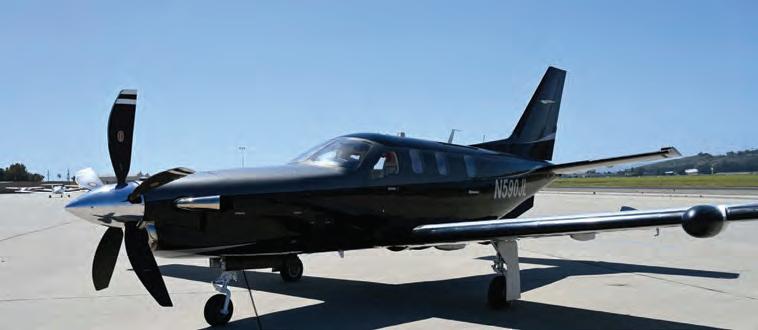
A Daher TBM 700, retrofitted with a Pratt & Whitney Canada PT6A-66D engine, is undergoing flight testing as part of Blackhawk Aerospace’s re-engining STC program.
Whitney Canada, Hartzell Propeller, and MT propeller to “further refine performance metrics,” according to Blackhawk. “In the first flight, the aircraft achieved higher speeds and altitudes than previous models, validating the engine’s improved performance using the existing certified components.”
The next steps in the STC program include detailed performance testing and specific inlet and propeller evaluations, with the goal
McLaren is showcasing its fleet of supercars this week at the NBAA-BACE just inside the main entrance of the Las Vegas Convention Center West Hall.
“Having these incredible cars alongside the world’s most advanced business aircraft will o er NBAA-BACE attendees a captivating look at what’s possible in engineering,

of achieving the STC in the second quarter of next year. Blackhawk said it has already “received multiple deposits securing delivery positions and continues to accept deposits for 2025 and 2026 deliveries.”
“This first-flight milestone represents a key advancement in our STC program, bringing increased power, performance, and sustainability to TBM 700 owners,” said Edwin Black, president of Blackhawk Aerospace. z
technology, and design, both on the ground and in the air,” said NBAA president and CEO Ed Bolen. “We are pleased to feature this new, exclusive lineup that provides an exciting look at the future of high-performance travel.”
Supercars on display include the 750S Coupe, hybrid convertible supercar Artura Spider, new convertible supercar GTS, and high-performance hybrid Artura.
“We are thrilled to display McLaren at the most esteemed aircraft show in the world: NBAA-BACE,” said Tom O’Gara, owner of McLaren Las Vegas. “Aircraft and supercars share so many characteristics both in materials and design characteristics. McLaren is having a tremendous year in Formula 1 racing, and our lineup of vehicles continues to delight our most discerning customers. We look forward to showcasing the model lineup among the aircraft at NBAA-BACE.” S.R.
The FJ33 and FJ44 family of engines won’t let you down. Our Total Assurance Program (TAP Blue) covers all engine maintenance for a fixed cost per flight hour, scheduled and unscheduled, including all service bulletins plus whatever nature throws at you. TAP Blue is the only engine maintenance program that covers foreign object damage (FOD) including bird strikes and lightning strikes. Simple, predictable, and affordable – you can rely on TAP Blue.

To sign up now for the highest levels of maintenance coverage ever o ered, contact us at www.williams-int.com, by e-mail at WIproductsupport@williams-int.com, or by phone at 1-800-859-3544 (continental US) / 1-248-960-2929 (other).

London-area Biggin Hill is about to get its long-awaited full instrument approach.
By Charles Alcock
London Biggin Hill Airport’s long-running efforts to upgrade its runway and all-weather status are set to yield results with the rollout in the next few months of four measures that should make it a more compelling option for business aircraft heading to the UK capital.
The privately-owned airport’s efforts owe as much to determination as innovation, with large investments made and up to five years expended seeking the required Civil Aviation Authority blessing.
In the fourth quarter, the agency is allowing live trials of a new Runway 3 approach that will mean its main runway has an IFR approach at both ends. “This means a more stable approach with a constant descent, and aircraft will spend less time flying over local residents,” explained Biggin Hill commercial director Robert Walters. “It means that many U.S. corporate operators, with company offices nearby here in the London area, will now feel able to use the airport.”
Another factor that has discouraged some operators from flying into Biggin Hill has been the lack of 24/7 weather service. This is now
fixed with the activation of AutoMet en route weather software that makes real-time data automatically available to flight crews.
“This is very good for transatlantic flights,” Walters said. “Until now, operators were faced with taking off from the U.S. at around 11 p.m. UK time and not knowing what the local weather would be here until air traffic control opens at 6.15 a.m. That can mean very little warning [if the weather worsens] and it can make people nervous. Now, they can get constant updates during the night.”
Another important investment at Biggin Hill has been made in a new instrument runway visual range system that accurately shows the horizontal visual range and is connected to the weather information service. Until now, the contour of the main runway has meant that the airport was restricted to stating maximum visibility as being 750 meters (about 2,460 feet), but the additional capability gives crews more complete information.
The airport has also committed to contractors that will resurface the runway and install new LED lighting along the centerline and
edges. Costing around $27 million, this work will be done at night to avoid disrupting traffic and will provide improved situational awareness for operators.
“All of these improvements combined make us much more on par with other London-area airports,” Walters said. While overall traffic levels so far this year have been close to those in 2023, the airport is seeing a higher proportion of larger aircraft.
Biggin Hill’s other big-picture objective is to serve as a generator of growth for the local economy so that its surrounding community sees tangible benefits in terms of goodquality jobs. Eight years ago, the airport conducted an employment study that found that, for every 1,000 aircraft movements, 40 jobs were generated. An update to this research conducted in recent weeks found that this number has increased to 88 jobs per 1,000 movements.
All of these improvements combined make us much more on par with other Londonarea airports...
— Robert Walters
Biggin Hill commercial director
“Part of that is driven by us not just being a taxi rank for aircraft,” Walters concluded. “Our ambition is to be a full-service center, an aerospace center, and a home base for more operators and companies. That is starting to play out through [service providers] such as Bombardier, Oriens Aviation, and Zenith.”
The airport is still pursuing its ambition to be home to a new aerospace skills college. After Marshall Aerospace pulled out of a planned partnership, it is now working with Bombardier to resurrect this plan. Also on the cards is a new accommodation block to house skilled workers who commute to and from their remote homes to work multi-day shifts in what is a high-cost area for housing. z
By Matt Thurber
Collins continues developing its avionics assets, from head-up displays (HUDs) to integrated flight decks for business aircraft ranging from Textron Aviation Beechcraft King Air 260s and 360s to Bombardier’s flagship Global 7500 and the upcoming Global 8000, as well as the Gulfstream G280. Collins pioneered fully touchscreen panel displays in the King Airs’ Pro Line Fusion avionics and also offers an upgrade with the Fusion touchscreen flight deck for Bombardier’s Challenger 604.
With its long history of HUD development, Collins Aerospace HUDs are the
platform of choice for a variety of business jets, including Gulfstream large-cabin and super-midsize models and Bombardier’s Global series.
With combined vision system overlays of enhanced and synthetic vision system imagery, Collins HUDs offer the latest technological features and enable enhanced flight vision system-to-land capability. This vastly improves dispatch reliability because pilots are able to land in much lower weather conditions instead of having to divert to an alternate airport.
Although targeting the military market, Collins Aerospace’s recent FAA technical standard order approval for the first multi-core processor covers civil and military applications. The
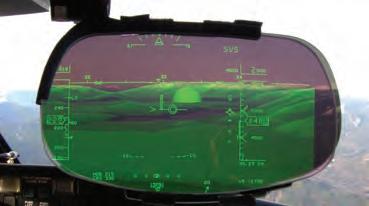
Collins’ HUD combined vision system overlays synthetic and enhanced vision system imagery.
multi-core processor “can process data 12 times faster than a single-core processor, consuming 40% less power,” according to Collins Aerospace, and will first appear in its MFD4068 multifunction display. z

By Matt Thurber
Since unveiling the Anthem avionics suite in October 2021, the Honeywell team has written more than six million lines of code, logged more than 10,000 hours of bench running time, and completed hundreds of flight hours in a Pilatus PC-12. Honeywell isn’t publicizing a date for when Anthem will enter service, but it is targeting a variety of market segments, from advanced air mobility (AAM) aircraft to Part 23 and 25 airplanes, both in the retrofit and forward-fit (new aircraft) arenas.
Three companies have thus far announced plans for Anthem avionics in their aircraft: Boom Supersonic for its supersonic airliner, which will also be available as a business jet, and AAM developers Lilium and Vertical Aerospace.
Aiming to meet the needs of small to large aircraft, from light airplanes to airliners and even military aircraft, Honeywell plans for Anthem to be a familiar environment for new pilots as they progress into more complex aircraft.
A typical Anthem flight deck will have three touch-display units (TDUs) replacing the traditional dual primary flight display and single multifunction display. Pilot interface display units (PIDUs) can be mounted in a center console or elsewhere. Each TDU can host a page that looks exactly like the PIDU, called a pilot interface window (PIW), so all the functions that control Anthem are available on any display.
Some planned Anthem features include a secure cockpit browser, which will enable certain software apps to run in a secure window, such as the web version of ForeFlight. A connected mission manager will provide a timeline view of an entire flight.
The PIW is the primary interface that pilots will use to manage Anthem, and its touchscreen has all the buttons for operating radios, planning a flight, and pulling up systems
synoptics. At the bottom of the PIW is probably the most unique feature of Anthem: the multiple data field or smart scratchpad.
Honeywell’s user-experience design team took the FMS scratchpad further into the future and made it much more useful. Touching the scratchpad enables the user to input various types of data, and the scratchpad
automatically recognizes the data type and prepares it for proper placement.
For example, when starting to type in a frequency, the smart scratchpad recognizes what it is and automatically suggests the full input for the user to accept or change. It knows the difference between a frequency and a transponder code or an altitude and where to put these numbers. z

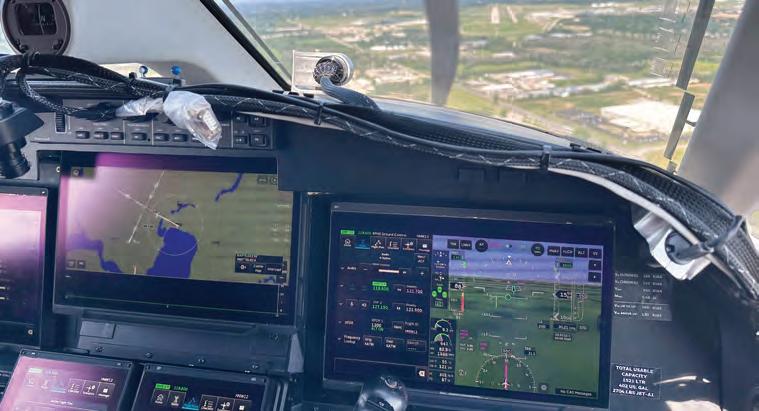
By Matt Thurber
With a long history of developing automatic flight control systems for airplanes and helicopters, including business jets such as Cessna Citations, Genesys Aerosystems also offers fully integrated flight decks. The Genesys Avionics Suite is primarily targeted at military and special-mission aircraft.
Cockpit displays are NVG-compatible, and they offer integrated area navigation and a

variety of sensor inputs. The suite’s master caution system gives voice warnings. The avionics suite, which is customized for military trainers, is matched with a Genesys digital autopilot.
According to Genesys, other features of the suite—to be installed in Grob Aircraft France’s Cobra TP-X trainer airplane—include “MILSTD environmental qualification, MIL-STD
1787B aircraft symbology, digital flight recording, incremental symbology progression, and advanced safety features like synthetic vision and embedded TAWS. Additionally, user-definable airspace and obstructions, customizable alerting, avionics open standards integration, plus Genesys’ patented Open Architecture System Integration Symbology enable future growth and obsolescence management.” z

By Matt Thurber
With the shutdown of the SmartSky Networks air-to-ground (ATG) network, the recent rapid growth of SpaceX’s Starlink aviation offerings, and Gogo Business Aviation’s imminent Galileo low-earth-orbit (LEO) service, the airborne connectivity landscape has suddenly shifted. SmartSky aimed to compete in the U.S. ATG space and got its network up and running, with equipment packages available for a variety of aircraft. An unknown number of installations took place at SmartSky dealer avionics shops, but the momentum just wasn’t there and it seems that there weren’t that many SmartSky systems installed. After spending hundreds of millions, SmartSky announced its surprise shutdown on August 16. This leaves aircraft owners who installed SmartSky systems in the lurch with no option to continue using their systems, and now they will have to pay again to install something else.
If ATG is the choice, then Gogo’s Avance L3 or L5 systems are the sole options. With seamless availability in the contiguous U.S. and parts of Canada and Alaska, Gogo’s coverage is more extensive than SmartSky’s was. An advantage for Avance L5 installations is that when coupled with Gogo’s MB13 antennas, switching to Gogo’s upcoming 5G service will be a simple matter of swapping one LRU. Gogo 5G is expected to launch in the second quarter of 2025.
positive experiences with home Starlink service. Although some people think that Starlink is only for big jets, due to the size of its electronically steered antenna (ESA), earlier this year Starlink demonstrated its system installed on a Beechcraft King Air 200. Since then, Starlink’s online list of supplemental type certificates (STCs) approved and under
dealers or airframe OEM service centers to develop their own STCs, which could speed up the approval process.
Although Starlink isn’t planning to deploy a smaller ESA, it is allowing owners of light general aviation aircraft to tap into its satellite network using a Starlink Mini ESA and the $250 per month (for 50 GB) Mobile Priority service. Top aircraft speed is limited to 250-knots groundspeed, and users must figure out a way to provide power to the system and mount the antenna, all in a temporary fashion to meet FAA requirements for non-installed, portable equipment.

development has grown considerably.
Starlink is generating a lot of buzz, according to avionics installation shops, and this may be due in part to aircraft owners’
One factor holding Starlink back from more rapid STC approvals is that it has been selective in which companies it wants to develop the STCs. So far, only three companies have done STCs, among them AeroMech and Nextant Aerospace for the business aviation market. Unlike other airborne connectivity providers, Starlink has not yet allowed its
The aviation-specific Starlink package costs $150,000, with installation bringing the total to about $300,000. Service costs range from $2,000 for 50 GB to $10,000 unlimited per month. Starlink speeds range from 40 to 220 Mbps download and 8 to 25 Mbps upload.
Gogo’s Galileo service is expected to launch this quarter, starting with its smaller HDX antenna. The larger FDX antenna will be available next year.
The Galileo service runs on Eutelsat’s OneWeb LEO network. Service speed for the HDX system is up to 60 Mbps download and 11 Mbps upload, while the FDX will offer 195 Mbps download and 32 Mbps upload. Monthly service pricing ranges from $3,500 for 25 GB to $10,500 for unlimited data. System hardware as an add-on to Avance L5 costs $120,000 for HDX or $190,000 for FDX.
Gogo has signed contracts with dealers for 25 STC programs that cover an addressable market of about 18,000 business aircraft, from Pilatus PC-12s and King Airs to light, midsize, and large business jets.

By: Sarah Rose and Matt Thurber
Gogo Business Aviation is buying Satcom Direct, a satellite communications hardware manufacturer and service provider, in a deal that took the business aviation industry by surprise when it was announced on September 30. Under the agreement, Satcom Direct will receive $375 million in cash and five million shares of Gogo stock at closing, and up to an additional $225 million in payments tied to realizing certain performance thresholds over the next four years. The deal is expected to close by year-end.
The move boosts Gogo into a much higher satcom orbit, adding Satcom Direct’s Plane Simple antenna and hardware product lines for geostationary (GEO) satellite networks such as Viasat and Intelsat to Gogo’s soonto-launch low-earth-orbit (LEO) Galileo system, which runs on Eutelsat’s OneWeb network. If anything, this acquisition will give Gogo a solid competitive edge and a full line of products, including its air-to-ground system in the U.S. and Canada, that will provide a counterbalance to business aircraft owners’ keen interest in SpaceX’s Starlink LEO satcom.
Satcom Direct confirmed that the Melbourne, Florida-based SD Data Center will be included in the acquisition. The company uses
this data center to provide a layer of cybersecurity for data to and from customer aircraft.
“This transaction accelerates our growth

strategies of expanding our total addressable market to include the 14,000 business aircraft outside North America, and delivering solutions that meet the needs of every segment of the BA market,” said Oakleigh Thorne, Gogo chairman and CEO. “Together, Gogo and Satcom Direct will offer integrated GEO-LEO satellite solutions that provide the highest performance of any satellite solution, along with the world-class customer support that the global heavy jet segment demands.”
“Satcom Direct is thrilled to be joining forces with Gogo, a company that shares our focus on delivering outstanding service and leading innovation,” said Chris Moore, Satcom Direct president. “Our businesses have highly complementary core competencies, and our combined financial strength and expertise unlocks opportunities to invest in new technology and deliver significant longterm value creation.”
The company said that members of the Satcom Direct leadership team are expected to join Gogo after the deal closes. z








BUSINESS JET TRAVELER’S 14th ANNUAL
Here are the results of our 2024 Readers’ Choice survey, which attracted over 1,000 respondents. As promised, we have made a contribution for every completed survey to Corporate Angel Network, which arranges fights on business aircraft to treatment centers for cancer patients.
If you could regularly fy on any of these aircraf, which would you choose in each category?
Pilatus PC-12 | 59 %
Cessna Caravan | 15 %
Daher TBM 960 | 15 %
Piper M700 | 6 %
Epic E1000 | 3 %
Daher Kodiak | 1 %
SINGLE-ENGINE TURBOPROPS
Beechcraf King Air | 82 %

Piaggio Avant P180 | 18 %

TWIN TURBOPROPS
Embraer Phenom 300E | 37 %
Pilatus PC-24 | 22 %
Cessna Citaton
CJ4 Gen2 | 18 %
Bombardier Learjet 75 | 16 %
Cessna Citaton
CJ3 Gen 2 | 8 %
Phenom 100EX | 36 %
Cessna Citaton M2 Gen2 | 36 %
Honda Aircraf HondaJet


Matt Thurber
Satellite manufacturer and operator Viasat has raised the bar on the performance of its Jet ConneX business aviation satcom and unveiled the new JetXP service with uncapped system speeds, expanded capacity, and more network prioritization for business aviation customers.
The JetXP service is available to customer aircraft equipped for Viasat’s Ka-band GX satellite network (formerly Inmarsat, prior to Viasat’s acquisition of Inmarsat last May). This includes airborne terminals sold by Honeywell, Collins Aerospace, and Satcom Direct. No new hardware is required to take advantage of JetXP, although the new service is an optional feature.
In 2021, Viasat uncapped service speeds on its satellite network, resulting in positive feedback from customers. Claudio D’Amico, Viasat business area global director, said this move “helped inform this enhancement program that we’re bringing to our Jet ConneX customers today. It’s the first step towards a broader harmonization of service and leveraging of assets that Viasat has access to right now.
“How we’re describing JetXP is an enhancement program for our Jet ConneX customers,” said D’Amico. “We’ve learned over the years, and have been evolving from the legacy Viasat, from extensive market research with OEMs, customers, and partners…that a good connectivity experience doesn’t come from a speed-based plan, especially one that’s just talking about peak data rates. Research shows that what represents that good experience is the reliability and consistency that you can deliver…to an operator to do whatever they want, be it entertainment, productivity tools, [or] applications, all of which require a lot of data.”
To deliver the enhanced JetXP service, Viasat has optimized its satellite network to
prioritize business aviation users and added more capacity. Hundreds of customers have tested the JetXP service with positive initial results, according to Viasat. Typical uses of the service include bulk file transfers, realtime entertainment, and web browsing. All of these “have traditionally performed strongly using Jet ConneX, but have become even more reliable, consistent, and snappy,” the company said.
To continue building its network, Viasat has launched more satellites. While its ViaSat-3 had an anomaly with a reflector, he said, “it is in operation and we’re seeing very good performance. The goal is to bring that to business aviation customers in the near future.” Viasat’s GX10A and 10B payloads launched on two Arctic Satellite Broadband Mission


satellites on August 11 and they are being positioned in highly elliptical orbits that will enable broadband service in the Arctic.
“There’s a plan to bring that capacity for business aviation, supporting the very few polar routes that we have in our world for those ultra-long-range cabin [jets],” D’Amico said. “We continue to work with different options of satellites and integrating them into our network as we see a specific need in the region or a customer use case that drives that. We have this robust product/satellite roadmap that enables us to continue to bring the capacity that exceeds the demand that we’re projecting.”
Viasat’s satellite assets aren’t just making connectivity available everywhere in the world, including remote areas such as oceans. The company is able to focus the capacity where it is needed and not where there is negligible airborne traffic. “We can translate that into that consistent and reliable connectivity experience that we’re trying to deliver over Teterboro at 9 a.m. on a Monday or Tuesday,” he said. z









Cessna Citaton
Lattude | 34 %
Embraer
Praetor 500 | 30 %
Gulfstream
G150 | 21 %
Cessna Citaton
XLS+ | 15 %
Bombardier Challenger 3500 | 38 %
Gulfstream G280 | 25 %
Cessna Citaton Longitude | 21 %
Embraer
Praetor 600 | 16 %
Gulfstream G700 | 36 %
Bombardier Global 7500 | 26 %
Gulfstream
G650/G650ER | 15 %
Dassault Falcon 8X | 15 %
Gulfstream G600 | 5 %
Bombardier
6500 | 4 %
ULTRA-LONG-RANGE/HEAVY JETS
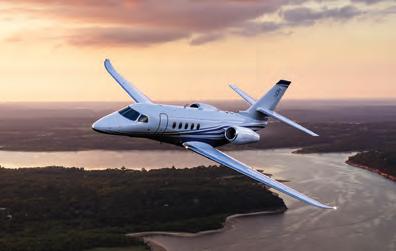


BIZLINERS
Boeing BBJ (737 series) | 34 %
Boeing BBJ widebody | 28 %
Airbus ACJ320 series | 14 %
Airbus ACJ widebody | 13 %
Airbus ACJ TwoTwenty | 11 %
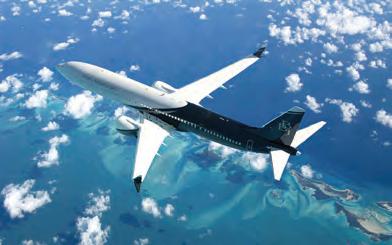

By Kerry Lynch
DaVinci Inflight Training Institute is drawing both new students and long-time crewmembers to its latest course offering surrounding aviation security. The business aviation training specialist teamed with Aviation Secure late last year to expand its portfolio in the security arena. DaVinci called the partnership a “momentous” step for both companies as they strive to step up critical safety knowledge and skills for crewmembers globally.
Under the training, DaVinci offers initial, recurrent, emergency procedures, and custom training modules through Aviation Secure, an NBAA-approved Professional Development Program provider.
The training, which can be taken online including through a single- or two-day course, focuses on building an effective safety culture, exploring policies and procedures, engaging one’s intuition, unmasking threats, assessing risks, improving passenger security, making crew transportation safer, understanding a changing environment, and knowing the security profile, among other topics.
In a one-day program, participants will undergo table-top security scenarios through teams, learn about essential security updates that should be part of the crew briefing, and receive training in areas such as anti-kidnap tactics and defenses, prevention and response of rideshare threats and survival of hostile hotel takeovers, cockpit breaches, and active shooters.
The two-day program will further delve into perimeter awareness, company culture, personal protection, preventative security policies, and case studies. Courses can be modified to tailor to a client’s needs.
According to DaVinci, the courses have been well received by those new to the industry as well as seasoned crewmembers. “The instructors, with their extensive backgrounds

in corporate aviation and high-level security, bring a wealth of practical knowledge to the program,” said Bettina Hohn, cabin safety and service instructor for DaVinci.
“The curriculum is not only comprehensive but also adaptable to the unique challenges of today’s aviation industry, ensuring participants are prepared for any scenario— from VIP protection to emergency response,” she added.
Key to the success of the program, Hohn said, is Aviation Secure’s “commitment to empowering aviation professionals with both the technical expertise and the soft skills necessary for high-stakes environments. The personalized approach, attention to detail, and focus on real-world applications leave our students with the confidence and skills to manage even the most demanding situations.”


By Matt Thurber
After Universal Avionics solicited creative solutions from employees on implementing artificial intelligence (AI) during its 2023 Grand Challenge, the company’s first products featuring AI technology are coming to fruition.
This week at NBAA-BACE 2024, Universal is demonstrating one of the concepts that resulted from the Grand Challenge—an AI-driven system that uses external camera inputs, audio capture, and ADS-B In information to paint a picture for the pilot of the situation at the airport while taxiing. The AI system taps into Universal’s FAA-certified Aperture visual management system, which delivers video inputs and imagery to flight deck displays and head-up displays (HUDs),
including Universal’s SkyLens head-wearable display (HWD).
“We’re going to develop these functions, which are AI-based, and incorporate them into our different product lines,” said Universal CEO Dror Yahav. “There is room for improvement of functionality and all of our product line using this disruptive technology.”
Where AI is being applied to Aperture is image content analysis. “We are training the system to identify objects in the EVS [enhanced vision system] image, and then, based on that, provide alerts to pilots,” he explained. “The more data we have, the better we will be able to offer new functionality and more accurate services.”
Data is captured from sensors such as Universal’s EVS-5000 multi-spectral camera mounted on the nose for HUDs and HWDs,
as well as external cameras that are already installed on many aircraft on the tail, belly, and elsewhere. The system also captures audio from the aircraft’s communications radios.
“We are recording [this information], and also it can be used for debriefing purposes and accident prevention. But the main reason we did that was to enable continuous learning, machine learning [by the AI system],” Yahav added.
The recorded data isn’t only useful for post-flight briefing but more importantly to provide real-time assistance to pilots. The AI system can isolate and ingest com radio audio and it knows which instructions are for its aircraft.
For example, if a controller clears that aircraft for takeoff, the AI system recognizes the registration number that the controller uses in radio calls to the pilot. Any other communications to other aircraft can safely be ignored, because they are for different aircraft (although presumably there could be future applications where the AI detects what other aircraft are up to, for example, to help prevent an incursion or potential collision).

Once the AI captures the controller’s message, it is displayed in text on the upper right side of the display (either head-down on an instrument panel display or head-up on a HUD or HWD). The message could be something simple such as “Cleared for takeoff Runway 26,” or more complex: “Taxi to Runway 26 via Delta, hold short of Runway 26.” In the latter case, the text annotation is backed up by a graphic depiction on the display showing a magenta line for the taxi route and a flashing white line at the runway threshold to indicate the “hold short” instruction. On a head-down display or even an iPad, the line will be in color, but in a HUD or HWD it would be monochrome.
The view will also show other objects such as aircraft identified by their call sign or registration number and ground vehicles to help improve the pilot’s situational awareness. Once cleared for takeoff, the horizontal line at the threshold disappears.
Yahav explained that the system won’t display communications for other aircraft because that would just clutter up the display. “It’s too much information. When you look at a full HUD image, it’s quite busy. We don’t want to give information which is not particularly relevant.”
However, the pilot can still see other traffic on the head-down display, HUD, or HWD, even if it is obscured visually by inclement weather, thanks to ADS-B In, and it is easy to match that traffic with the display of its call sign via incoming radio calls.
Another technology that Universal is highlighting this week at BACE is voice activation incorporated into a software-based flight management system (FMS). The plan is not to use voice activation for simple tasks (such as a direct-to-command) but for complex situations.
One example is reprogramming an instrument approach or arrival procedure at the last minute, which takes a lot of button pushing on a traditional FMS control-display unit. The idea is that the software-based FMS will hear the radio call from a controller and automatically modify the flight plan, then simply ask the pilot to approve the change.
Meanwhile, Universal is tackling the problem of LED lights that are increasingly being installed in approach light systems because incandescent lighting is no longer available

The air traffic controller’s instructions are shown on the top right in this enhanced vision system head-up display image, along with highlighting the proper route over the ground.
or too costly. Many EVS-capable aircraft can’t show LED lights because the system’s camera doesn’t include a sensor that can pick up LEDs, whereas incandescents are easy because they give off lots of heat that is easily detectable by thermal sensors.
So Universal’s EVS-5000 camera is designed to work with LEDs and has proven in flight tests that it can detect them in low-visibility conditions. This will allow operators to obtain operational credit for low-visibility landings where approach lights use LED lighting.
The EVS-5000 is installed on Textron Aviation Citation Longitudes equipped with Garmin’s GHD 2100 HUD, Dassault Falcons with Universal parent company Elbit’s HUD, ATR 42s and 72s (SkyLens HWD), Boeing 737NGs, and Embraer C-390s, among others. The ATRs have been approved for a 50% visual advantage (increase in forward visual range) that allows landings in lower visibility, and Universal expects further such approvals for EVS-5000-equipped aircraft.
Universal is also displaying its InSight Display System integrated avionics suite at BACE—not only at its exhibit but also at booths of Universal Avionics dealers Chicago Jet, StandardAero, Trimec, and Southeast Aerospace.
Installations of InSight are ramping up, Yahav said. “During the last two years, we’ve completed a big set of STCs.” These include the Falcon 20, 50, 900, and 2000EX; Citation VII; Hawker 800/A/XP; and Gulfstream III.
These aircraft models still “can fly for many years, the engines are good and being supported. But the weak link is the avionics, which become obsolete,” he said. Additionally, operators need advanced functionality that InSight adds, such as LPV approaches, controller-pilot datalink communications, FANS 1/A, ATN B-1, and ACARS.
Customers also want to connect their iPads to the avionics for database updates and downloading aircraft data, which InSight offers, as well as a flight operations quality assurance service.
“There are a couple dozen InSight systems installed,” Yahav said, “but many of the STCs are new and we expect to see a big funnel of customers doing upgrades.”

by Stuart “Kipp” Lau
With the release of the FAA’s final rule requiring safety management systems (SMS) for Part 135 operators, air tour operators, and type certificate holders, the questions become what does this mean for organizations and are they ready. The final rule was published on April 26.
The number of affected organizations is significant, and they have less than 36 months to comply with the new SMS mandate.The deadline for an operator to provide the FAA a Declaration of Compliance (14 CFR 5.9) is May 28, 2027. It’s important to note that from a regulatory compliance perspective, the Declaration of Compliance is the end of the SMS development and implementation process—not the beginning.
NBAA provided significant feedback to the FAA leading up to the new SMS rule. The final rule reflects much of that feedback, including scalability, an exclusion for single-pilot operations, and an expansion of the implementation timeline from 24 to 36 months.
“The business aviation community has always considered safety to be a core value and has led the way in voluntary adoption of SMS and other best practices,” said NBAA president and CEO Ed Bolen. “This final rule largely reflects comments from NBAA and
hundreds of others who have noted that for an SMS to be effective, it must be tailored to the size and complexity of each operation.”
Most organizations are supportive of SMS, seeing strong safety benefits. Even so, several business aviation safety professionals believe there will be a substantial impact as operators prepare for SMS implementation.
“The most significant impact for business aviation and air tour operators will be allocating resources for the development, implementation, and ongoing management of the SMS,” said KB Solutions CEO Kodey Bogart. “This includes hiring or training staff dedicated to safety management and investing in software or systems for tracking and analyzing safety data as necessary.”
Bogart, a safety program consultant, educator, and former Black Hawk helicopter pilot, added, “The initial costs of SMS implementation can be significant, and smaller operators may find these costs particularly challenging. However, operators need to remember that an SMS does not have to be overly daunting and can be kept simple and scalable to the organization’s size.”
Air Charter Safety Foundation (ACSF) president and CEO Bryan Burns does voice some concerns, particularly how the FAA will evaluate and assess for compliance
once a Declaration of Compliance is submitted. Burns believes that 36 months is an adequate amount of time to implement an SMS “as long as the operator starts now.” He added, “In my view, we should continue to focus on what reinforces an effective program with an emphasis on leadership, culture, and professionalism.”
Since the FAA published the final rule, the ACSF has experienced an uptick in requests for support, Burns said. “We receive two to three requests per week to demonstrate and view our SMS tools and platform.”
Sonnie Bates, CEO of aviation safety specialist Wyvern, has mixed views on the business aviation community’s readiness to adopt an SMS. “Most air charter operators are scrambling to meet the requirements of this rule. Most of them do not have a viable SMS,” he said, “or they have a documented SMS but they lack the tools, training, and culture to make it work.
“The way it should be done is for leadership to commit to having a positive safety culture and through that commitment require the implementation of an SMS and not do it because some outside entity required it. Those who have waited this long to implement an SMS because the FAA has finally mandated it are way behind the power curve as it’s likely their leadership has not committed to ensuring a positive safety culture.”
ACSF’s Burns agreed and believes the new rule is important to the charter industry. “It all starts with company culture,” he said. “Employee buy-in is crucial for the success of any safety program. However, most importantly [for] senior management and leadership…without safety as a core value of an organization, the SMS program will not succeed.”
Bates cautions operators from taking this mandate lightly. “I think operators who do not already have an SMS are thinking this will be easier than it really is. But what the operators will soon realize is that SMS requirements are complex and require a cultural shift.”
KB Solutions’ Bogart thinks many operators are trying to determine what the new SMS rule means to their organization and suggests that a good first step is a discussion with a consultant. “Organizations are still trying to wrap their head around what the regulation means for their organization.” z
Hosted by:
NBAA-BACE, Las Vegas, NV | October 23, 2024 | 12 pm PT

Sponsored by:
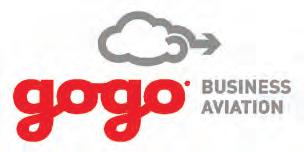
Limited seating. Lunch will be provided.
Join us for lunch at NBAA in Las Vegas to hear from a distinguished panel of experts who will discuss the options for satellite internet.
Gain a deeper understanding about:
+ Today’s data demands
+ Game-changing LEO satellite technologies
+ Looking beyond speed, what else you need to know
Panelists include:
Matt Martin - Product Manager, Gogo Business Aviation
Mark Sander - SVP of Sales, Gogo Business Aviation
Jason Sperry - Head of Business Aviation, Eutelsat OneWeb
Jeremy Tyler - VP of Engineering, Airborne Products, Gogo Business Aviation
REGISTER TODAY

connect.ainonline.com/gogo-lunch-2024
By Hanneke Weitering
Maintenance, repair, and overhaul (MRO) service providers are increasingly relying on artificial intelligence (AI) to make their work more efficient and reliable. In recent years, AI technologies such as computer vision, predictive analytics, and machine learning have percolated into just about every facet of MRO processes—from engine inspections to supply chain management to administrative tasks.
While business aircraft manufacturers and MRO service providers have been using forms of AI technology to automate some simple processes for years, recent advances in generative AI have opened the door to a world of new applications. For example, generative AI can automatically create maintenance log entries and reports, and it can analyze sensor data to predict when parts may require maintenance. It can also handle more mundane tasks such as customer service emails.
Over the summer, engine maker GE Aerospace began rolling out a generative AI platform for employees to use as a virtual assistant. Called AI Wingmate, the platform works similarly to ChatGPT: workers interact with a chatbot to search for information, spitball ideas,
and generate written communications tailored to specific audiences. The company said AI Wingmate received more than 500,000 queries from employees between June and last month.
“Generative AI is changing the way we all work, enabling us to be more productive with our daily work tasks than ever before,” said GE Aerospace chief information officer David Burns. “Ultimately, this will strengthen our ability to help the aerospace industry meet our highest objectives of enhanced safety, sustainability, and reducing supply-chain constraints.”
Automating inspection processes with robotic inspection tools and computer vision software not only saves time compared with manual inspections, but it also helps to ensure quality control, making inspection results more reliable.
At GE Aerospace’s Services Technology Acceleration Center facility, which opened last month near its Cincinnati headquarters, the company is introducing automated inspection processes that it said will make the inspection process more efficient and consistent. Equipped with white light optical scanners, robots automatically capture detailed images of a part. Rather than having humans look for defects such as scratches or corrosion, the

system uses AI technology to analyze the imagery and identify potential issues.
Pratt & Whitney also recently launched an AI-based aircraft engine analysis tool for geared turbofan (GTF) and V2500 powerplants. Called Percept, the inspection tool combines computer vision technology with a video intelligence operating system developed by Indian AI start-up Awiros.
The company’s maintenance technicians use a cloud-based interface on a mobile device to capture images of an engine, and the app provides real-time parts availability status. According to Pratt & Whitney, Percept has reduced the time it takes to conduct an engine inspection by nearly 90%.
Automated inspections are now also being conducted by drones. For example, business aircraft service specialist Jet Aviation recently gained approval from the Swiss Federal Office of Civil Aviation to use AI-enabled drones to conduct general visual inspection work.
It uses drones to capture images of an aircraft’s entire surface and AI software then analyzes the images to identify defects and generate a digital report. Jet Aviation first introduced its AI drone inspection technology last year for nonregulated services such as prepurchase aircraft structure inspections, paint quality checks, and other inspections required for insurance and warranty purposes.
AI also enables more streamlined approaches to managing inventories and supply chains. Demand forecasting tools that use AI became incredibly valuable during the Covid-19 supplychain crisis that plagued MROs with delivery delays and parts shortages.
Pratt & Whitney’s Percept engine analysis tool merges computer vision with a video intelligence operating system to help reduce engine inspection times by as much as 90%.
Bombardier is a pioneer of AI-driven demand forecasting in the aerospace industry. To improve its aftermarket demand forecasting process, Bombardier’s inventory planning team partnered with Canadian AI start-up Ivado Labs to develop a predictive analytics pipeline that leverages machine-learning models.
Similarly, Honeywell Aerospace recently began using AI and machine learning to help manufacturers and MROs modernize their processes and save costs by leveraging data to inform critical decisions. Honeywell unveiled cloud-based software solution Forge Performance+ in April as an addition to its Forge suite of digital tools for manufacturers and MROs. z
By Jessica Reed
Led by Thales, the DECOR project is an ambitious initiative designed to reduce the environmental impact of air transport operations through advanced digital solutions.
Supported by the French Civil Aviation Authority (DGAC) and funded through the France 2030 investment plan, the public-private collaboration aims to develop and demonstrate technologies that optimize flight paths.
The aim is to improve air traffic flow management to help the aviation industry reach its goal of net-zero carbon emissions by 2050. Partners in the DECOR project include Airbus, Air France, Amelia, Atmosphère, Cerfacs, CGX Aero, FRACS, and Onera.
“This latest illustration of Thales’ commitment to tackling climate change is a practical, large-scale demonstration of the French air transport industry’s efforts to reduce its environmental impact,” said Yannick Assouad, executive v-p of avionics at Thales. “The DECOR project is the next step toward achieving flight path optimization and will help to reduce the CO2 impact of flight operations by 10% before the end of the decade.”
DECOR is an abbreviation for “démonstration d’opérations eco-responsables” (demonstration of eco-responsible operations). At the core of the DECOR initiative is its focus on leveraging digital solutions to enhance collaboration between air navigation service providers and pilots. By optimizing flight trajectories and reducing airborne delays, the project seeks to minimize both CO2 and non-CO2 emissions.
Thales’s expertise in avionics and air traffic management plays a critical role in these developments, building on the Green Flag airspace management concept it developed and flight-tested in partnership with Air France and the French air navigation service provider DSNA.
DECOR’s approach includes large-scale simulations and real-world tests on both regional and long-haul flights to evaluate the effectiveness of its proposed solutions. Beyond using flight-path optimization to achieve a reduction in CO2 emissions, further improvements are expected as technologies evolve.
“A range of simulation and decisionsupport solutions makes it easier for aircraft operators (dispatch and pilots) and air navigation service providers (flow managers and controllers) to work together to implement lower-impact routes including the necessary network assessment,” according to Thales.
The project also aligns with broader international efforts, such as the SESAR 3 JU program in Europe, to enhance the environmental performance of air traffic management systems.

The DECOR project aims to reduce environmental impact of operations by optimizing flight paths.
By addressing operational inefficiencies in real time, DECOR is paving the way for sustainable aviation practices in the near term, while the industry awaits the full-scale implementation of technologies such as sustainable aviation fuel and low-emission aircraft. z


Report by Curt Epstein, charts and data by Dave Leach
For the major business aviation market of North America, 2023 experienced a decline in flight activity compared with the previous year as the industry continues to stabilize from the Covid-era boom. According to Aviation Business Strategies Group’s (ABSG) annual fuel sale survey, 41% of the FBO respondents noted they experienced lower fuel sales last year compared with 2022.
“After FBO fuel sales recovered in 2021 to pre-pandemic levels, we have seen a gradual softening across the market spectrum over the past two years,” said ABSG co-principal and FBO industry veteran John Enticknap. “This downward trend seems to indicate that the general aviation market is testing a lower annual fuel volume as jet-A prices remain mostly elevated.”
According to Argus International’s TraqPak data, 2023 business aviation flight activity declined 3.3% in North America when compared with 2022. Despite this, some U.S. FBOs AIN spoke with in its annual FBO survey indicated that 2023 was a record year for them. Argus points out that comparing last year with 2019 shows an 11.8% increase in 2023 and argues that without Covid, it would equate to a rather normal 2 to 3% annual increase.
European activity declined 10.2%. December 2023 showed the lowest monthly activity, signaling a return to pre-Covid activity patterns.
FBO operators in ABSG’s survey support this view: 41% believe their fuel sales will be flat this year and 30% anticipated a modest increase in fuel sales from 2023.
While record-breaking consolidation activity has taken place in the FBO market, that pace should cool as larger chains pause to digest recent additions. “This is not to suggest there is a buyer’s fatigue, rather, with every acquisition comes the need for integration, optimization, and stabilization,” said Douglas Wilson, president and senior partner of consultancy
FBO Partners. “To a certain extent this creates a human resourcing tax in further acquisitions, as many of the same [M&A teams] that conduct the acquisition then pivot to integration mode.”
Wilson noted an evolution in how airports choose to award FBO leases, centering on sustainability. “[Request for proposals] scoring criteria has changed and changed significantly,” he told AIN, adding the subject is now receiving increased consideration.
“The cost of achieving sustainability must be passed along to an end-user customer,” Wilson said. “While a tenant may not care if the hangar they base in has LED lighting, solar panels, geothermal heat, or a roofline designed to capture rainwater runoff, those requirements of an airport make them more expensive to build.”
In the AIN survey this year, Texas and Florida dominated the top 5% of the FBOs, with those states each fielding five locations or one third of the top tier each. No other state had as many as two, with the remaining five slots filled by facilities in Michigan, Tennessee, Colorado, Alabama, and Idaho.
To reach those highest rungs, an FBO must excel in more than one or two areas. This year, while two locations each earned the highest scores in two of the five categories, one ranked among the top 20% of FBOs in the Americas, while the other placed below that threshold. To attain the highest overall rankings, an FBO must exhibit excellence across all five categories in the eyes of its AIN reader customers. z

Let the Good Times Fly… Navigating Tomorrow, Today! The 2025 NBAA Schedulers & Dispatchers Conference (SDC2025) is where your journey towards success takes flight. Elevate your logistical planning and explore the latest in dispatch technologies and innovative equipment designed to propel your flight department operations to new heights. In the spirit of New Orleans, where timeless charm meets innovation, start planning today to ensure you’re part of this exceptional event you won’t want to miss!

By Kerry Lynch
NBAA has a packed agenda on the regulatory and safety front this week at BACE, including NTSB member J. Todd Inman as a keynote speaker at the association’s National Safety Forum being held in conjunction with the three-day convention.
Inman, who joined the Safety Board in March, has brought a range of federal, state, and private sector experience to the agency, including in the Office of the Secretary at the U.S. Department of
Transportation and in the special investigative unit at State Farm Insurance Companies. Inman is speaking on Thursday during the “Leadership Perspectives on Aviation Safety: Vision for the Future” session that runs from 9 a.m. to 9:45 a.m. at NBAA’s Safety Education Center in the Las Vegas Convention Center.
“Business aviation is a leader in the development of robust safety practices and fostering effective safety cultures and solutions,” Inman noted. “I look forward to participating in the National Safety Forum and NBAA-BACE,


and to engaging in a thought-provoking discussion on business aviation safety.”
The forum is taking place throughout BACE with safety sessions scheduled for each day on topics ranging from Part 5 safety management systems and flight data monitoring programs to mental wellness. The forum culminates on Thursday morning.
In addition, NBAA-BACE hosted its SinglePilot Safety Standdown and Small Operators Symposium yesterday and is featuring a range of key government officials and regulators throughout the show. This includes FAA Administrator Michael Whitaker, who is scheduled to speak this morning at the opening session.
House Transportation and Infrastructure Committee Chairman Sam Graves (R-Missouri) and ranking member Rick Larsen (D-Washington) also participated in a Newsmakers Luncheon yesterday. A Meet the Regulators Session today at 4 p.m. at the Flight Deck Pavilion will feature Tim Arel, COO of the FAA’s Air Traffic Organization; David Boulter, associate administrator for aviation safety for the FAA; Laurence Wildgoose, FAA assistant administrator for policy, international affairs, and environment; and Holly Canevari, deputy administrator of the Transportation Security Administration. z
Editorial inquiries: Charles Alcock calcock@ainonline.com, +44 7799 907595
Advertising inquiries: Victoria Tod vtod@ainonline.com, +1 (203) 733-4184
By Curt Epstein
Following NBAA’s sale of its stake in the European Business Aviation Convention and Exhibition (EBACE) earlier this year to its partner European Business Aviation Association (EBAA), the annual show will go on, according to EBAA chief operating officer Robert Baltus.
Speaking to AIN on the eve of NBAA-BACE in Las Vegas, Baltus confirmed that the next EBACE event will take place May 20 to 22 at the Palexpo convention center in Geneva, Switzerland.
“The show will be close to what the show was last year,” Baltus said. “We are starting the process of reaching out to all the different stakeholders, the exhibitors, the attendees, and also our membership to find out what we expect from the show, what do we want, where do we want to go with the show,” Baltus said.

The trend of major airframers questioning the need to attend major trade shows is also a factor in future planning. “Shows used to be the only place where you would go, [but] nowadays all the OEMs have their own [demonstration] fleet and they tend to go out and show the fleet to potential customers,” he stated. “That was a big change in the industry.”
Aviation Partners, an innovator in aircraft winglet technology, is collaborating with 4Air to o er emissions footprint assessments to its clients. The partnership with 4Air, a provider of aviation sustainability solutions, aims to help aircraft operators better understand and manage their environmental impact.
Robert Baltus EBAA chief operating officer
With EBACE now only seven months away, Baltus expects more noticeable changes could come in the 2026 and 2027 editions. “But as many things as we can do, we will do in 2025,” he said, noting those changes could come in the form of the show layout with specific areas for specific audiences.
EBACE launched in 2001, and with the exception of the Covid years in 2020 and 2021, the show has happened every year. With more than two decades of co-proprietorship between NBAA and EBAA, Baltus explained that it was more work than expected to unwind the show.
“It was NBAA and EBAA’s baby, and the role of the NBAA has been huge in the whole thing,” he explained, adding that the relationship between the two organizations is excellent. “EBAA is immensely grateful for the NBAA and all they have done. We couldn’t have grown the organization and the show as much without their help.”
“At the same time, there’s only one show, once a year where all the OEMs, all the operators, all the suppliers can get together. If it’s all small shows, nobody wins because this is the one place where all the industry can get together and have a united front with a united message.”
In 2023, the show was disrupted when a group of protestors stormed the static display at Geneva Airport. “This has been hugely embarrassing to Geneva,” explained Baltus, adding that the city went out of its way this year to bolster airport security to prevent a repeat.
In the face of such protests, Baltus added that it is imperative to educate people on how the industry is working to reduce its environmental impact. “That’s what the wider world needs to know, and the show is a great platform for that,” he said.
When asked about the prospects of the show moving from its long-time host city of Geneva, the EBAA executive was quick to point out the venue’s advantages. “There’s no other location where you have the airport and that much exhibit space next to one another, [and] it’s a great city with five-star hotels,” he said.
Five years ago, EBAA did a study to identify alternative locations and found very few that would meet the criteria of the exhibitors, attendees, and organizers, Baltus said. “We’re not married to any concept or location, the most important thing is those three parties feel it’s worthwhile.”

Noting its winglet technology has contributed to reducing more than 150 million tons of carbon emissions since 1992, Seattle-based Aviation Partners will now provide new clients with 4Air-certified sustainability tracking for one year following winglet installation. These assessments give operators detailed insights into their carbon footprint, with the goal of guiding them toward compliance with sustainability regulations.
According to Aviation Partners, its winglets “reduce drag and fuel burn, extending aircraft range and improving takeo and climb performance.”
“Aviation Partners winglets have helped transform aircraft, increasing e ciency and performance, while giving owners and operators a path to achieve their sustainability goals,” said company president Gary Dunn. He emphasized that the partnership with 4Air enables clients to commit to verified and measurable sustainability e orts. J.R. 4Air helps operators better understand and manage their carbon footprints.

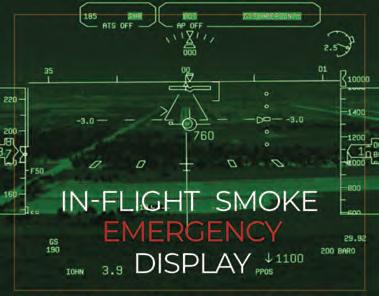
by Curt Epstein
Safety equipment designer Klatt Works is making its debut at NBAA-BACE this year with its Smoke Assured Vision Enhanced Display (SAVED) full-face oxygen mask with integrated head-up display (HUD).
At the show in Las Vegas, the Pleasanton, California company announced the start of its
first business aviation supplemental type certificate (STC) for the system, which will see its installation in BLM Aviation’s Gulfstream G550 and pave the way for integration in both the G550 and G450 models. The company has already secured an STC for its use in the Boeing 777 commercial jetliner.
The lightweight wearable provides pilots with an augmented-reality system that
by Sarah Rose
Collins Aerospace has shipped out the first deliveries of its upgraded Venue cabin management system, which features smart monitors and upgraded graphical user interfaces that the company says enhance entertainment.
The Venue system has already been installed more than 1,700 times across 50 different aircraft models. The enhanced system sports 4K-enabled resolutions, cabin controls, and a redesigned user interface in what the company calls a “simplified, consistent experience” using its touchscreens, seat controls, and mobile app.
“The enhanced user interface and smart architecture not only advance Venue’s market-leading capabilities and dependability but also establish a firm foundation on which customers can seamlessly build onto their system as future technology upgrades become available,” said v-p and general manager of business and regional avionics Nathan Voight.
The system is available in five sizes with a smart monitor that boasts “flexible integration options” across VVIP aircraft to light jets.
“Collins’ network of trusted dealer partners has been instrumental in the integration and deployment of our upgraded Venue system, evolving the
delivers information to display screens inside the mask for use during cockpit smoke emergencies when pilots cannot see the flight instruments or even the view outside the cockpit windows.
SAVED provides HUD vision relayed from a nose-mounted camera, allowing the crew to aviate during extreme smoke emergencies with visual references to land or ditch the aircraft. It can receive video in SDI or NTSC format through dual 720p, 4:3 biocular seethrough displays, with adjustable brightness for day or night operation, and is usable with corrective lenses. Power is provided via dual redundant left and right cockpit buses.
The company has established a full endto-end value chain for the product. Ametek Ameron will integrate the SAVED system into the standard two-piece MF-20 pilot masks and offer ongoing maintenance and service based on customer requirements.
For the certification, L2 Aviation will take the lead in the application process and handle the production of the SAVED kits, while EFI will support the initial installation on the G550 as well as perform future installations.
The certification plan was submitted to the FAA, and the companies anticipate receiving STC approval by February 2025. z

in-flight experience to what passengers expect in-ground applications,” added Voight.
Demonstrations of the Venue system and Collins’ upholstery solutions are being showcased at the Collins Aerospace booth during NBAA-BACE. z












AIN Media Group is excited to announce our inaugural









March 27, 2025 | The National WWII Museum | New Orleans, LA

Join us for AIN’s FBO Dinner & Awards Gala, a prestigious event dedicated to celebrating excellence in the business aviation industry, as we announce the top performers from our survey.
The event will take place on Thursday, March 27th, 2025, from 6 pm to 9 pm in the U.S. Freedom Pavilion at The National WWII Museum in New Orleans. This exclusive evening will feature a formal dinner and an awards ceremony.
This event promises to be an unforgettable night of networking, recognition, and celebration among the leaders in aviation.
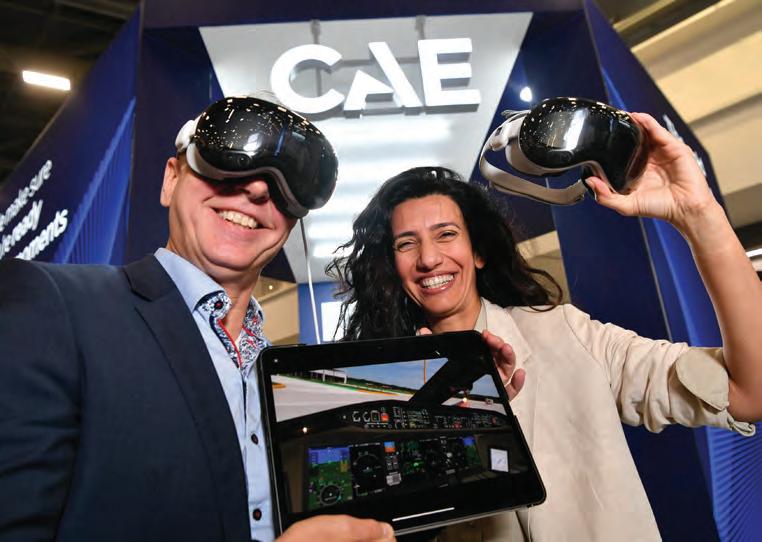
By Jessica Reed
CAE has developed the first immersive pilot training app for Apple Vision Pro. The app, which CAE is demonstrating at NBAABACE, harnesses the power of spatial computing to improve how pilots train for flight deck interactions.
With this solution, CAE aims to shift aspects of pilot training from traditional training centers to remote environments. By providing pilots the ability to engage with flight deck controls and practice critical procedures from anywhere, the app could enhance flexibility and convenience in pilot training. CAE’s app promises to not only improve the speed and effectiveness of training but also help pilots build muscle memory for operating various aircraft systems.
“The power and unique capabilities of Apple Vision Pro, combined with CAE’s
training environment, will give pilots more flexibility and better prepare them for the transition from ground school to the simulator,” said Alexandre Prévost, CAE’s division president of business aviation training.
Emmanuel Levitte, CAE’s chief technology and product officer, said the app “will allow pilots to familiarize themselves with the flight deck, practice critical procedures, and develop muscle memory for key functions from anywhere. It will allow pilots to engage with realistic flight deck environments to further ensure they are ready for their full-flight simulator sessions and become even better prepared for any situation.”
The app offers three interactive modes. Exploration mode allows pilots to touch a specific control and view a description of its function. Guided mode walks them through procedures in a step-by-step sequence. The flight deck interaction mode lets pilots
simulate natural interactions with the virtual flight deck, replicating real-world tasks such as activating the main battery switch.
CAE’s app, now in testing for the Bombardier Global 7500, will be available by the spring of 2025 and is set to complement existing training programs for both business and commercial pilots. With a growing demand for new pilot training, CAE’s innovation can enhance pilot readiness and efficiency.
I had the opportunity to try out the app using an Apple Vision Pro headset during a demonstration at NBAA-BACE. Erick Fortin, senior director of incubation at CAE, told AIN, “When the Apple Vision Pro came on the market last year, we wanted to know if we can give a virtual cockpit to every learner to learn how to fly the next aircraft.”
“For example, if you’re the pilot and you need to fly a different aircraft, you need to go back and train. That’s a good thing—learning to fly a new aircraft,” Fortin explained. Now, those learning to fly could learn in the classroom with CAE and also continue learning and practicing at home or in their hotel room.
“The other question is, can you interact with a cockpit and a controller that you cannot touch? In the past, maybe you saw some people using joysticks. Now, we [just] do it with our hands.”
The device first needs to calibrate to the individual user’s eyes, which takes about a minute and a half. When the demonstration started, I used simple gestures to navigate, including tapping the air and touching my thumb and index finger together—a “pinching” motion—to interact with the flight deck and activate the main battery switch with ease.
While wearing the headset, I was able to read nearly everything on the virtual flight deck. “A few years ago, that was impossible,” Fortin said.
“It’s a new tool, and so far, we received great feedback,” he added, saying, “We are still developing this application; it’s not fully released yet.”
CAE plans to make the app available for other aircraft in addition to the Global 7500, according to Fortin, who told AIN , “At the moment, we do not need to work on more aircraft. The goal is to fine-tune the application.”
As the testing phase progresses, the team will focus on evaluating the aircraft’s systems and overall performance.
The CJ4 was the first Citation to get a Gen2 upgrade and the Gen3 move signals that Textron Aviation is moving faster with improvements that customers have been requesting.
“[We’re] constantly getting asked ‘what’s next,’” said Textron Aviation president and CEO Ron Draper. “This is heavily based on customer feedback. We’ve been working with our customer advisory boards over the last couple of years on these products and to make this announcement. I think this shakes up the entire light jet industry and is an enormous enhancement to our existing great product lineup.”
The M2 and CJ3 are also getting a Gen3 treatment, and the major feature will be adding Garmin’s Autoland technology. Certification of the M2 and CJ3 Gen3 models is expected in 2026. Owners of M2 Gen2 and CJ3 Gen2 models, which brought autothrottles to these airplanes, will be able to upgrade to Autoland through a service bulletin.
“This product-driven, customer-driven product strategy is resonating with the
continued from page 4
longest range, lowest cabin altitude, and smoothest ride is coming next year,” he said.
The aircraft, which is expected to enter service in late 2025, will feature a range of 8,000 nm, allowing it to connect city pairs such as Singapore-Los Angeles, Dubai-Houston, and London-Perth, at a top speed of Mach 0.94.
Production of major components is currently taking place at Bombardier facilities in Saint-Laurent, Québec; Red Oak, Texas; and Querétaro, Mexico.
A retrofit kit will be available for Global 7500 customers looking to bring their aircraft to the 8000 standard, a process that will take approximately 10 days in a Bombardier service center, according to Paul Sislian, Bombardier’s executive v-p for aftermarket services and strategy. It will include a larger fuel capacity as well as avionics and engine software changes.
Jean-Christophe Gallagher, executive v-p of aircraft sales and Bombardier defense, noted that the manufacturer is about to reach a
marketplace,” said Jimmy Beeson, Textron Aviation’s senior manager of technical marketing. “It’s exciting when they come to you and say, ‘What’s next?’ and we continue to deliver with changes like this.”
Garmin G3000 Prime isn’t the sole upgrade for the CJ4 Gen3. In addition, it will be equipped with new winglets fitted with an informal accent light on the upper edge “to add in excellent ramp appeal,” he said.
Interior acoustics are also improved with new materials helping reduce noise in the cockpit and cabin. Furthering the penetration of lithium-ion main-ship batteries in business aircraft, the CJ4 will have a True Blue Power Li-ion battery that improves starting power and lowers weight.
Further, both the flight deck and cabin will have lighting improvements. Lighting is added to side pockets at each seat and improved floodlighting illuminates the seats along with updated reading lights with directional control and variable scope.
“We continue to focus on sustainability,” said Christi Tannahill, senior v-p of customer experience. “And the CJ4 Gen3 is no different [with] a fully sustainable interior. We work closely with our customers to provide
materials, carpets, even the veneers, everything that’s available for them if they choose to bring on the entire sustainability path.
“What makes this easy for us is all of our materials are sustainable and biodegradable. We use the remnants, everything that we can. It also shows that our sustainability can mean luxury. You can have the stone floors, the beautiful sinks. We do some neat [work] over at IMF, our manufacturing facility that does all of our furniture. They’ll take remnants of wood and make amazing designs.”
“What’s unique about the Gen3,” Tannahill added, “is these were the same customers that came to us in 2021. We talked about the interior and we added everything that they were looking for. Our customers have always told us, ‘You bring us in, and you do what you say that you’re going to do,’ and they’re very excited about the product because it’s what they’ve created. At Textron we continue to look at the avionics, the technology, anything that would make the airplane better.
“And so just because we touch an airplane doesn’t mean that we’re done. We’re going to continue to invest. And this was a unique experience of how we did that.” z

milestone for the Global 7500 with its 200th delivery since its certification in 2018, to be followed soon after by the 100th delivery of the Challenger 3500 and the 1,000th delivery of a Challenger 300-series jet.
He noted that the company’s Global 7500 demonstrator, which travels the
The first production example of Bombardier’s Global 8000 ultra longrange business jet is taking shape at the company’s U.S. aerostructures production facility in Red Oak, Texas.
world showcasing the company’s technology, has racked up an impressive slate of 60 National Aeronautic Association-certified speed records—“records that can only be accomplished with a combination of range, speed, and takeoff performance,” Gallagher said. z
“We’re in a very robust and very resilient place,” he said, explaining that the predicted economic growth is the same average growth rate the U.S. has seen since the 1960s.
Vincent noted that the industry backlog has stood at approximately $50 billion for the past three years. “We’re not clearing out the backlog, but the good news is the backlog is holding,” he stated. “We’re not in a demand-weakened world; people want what we do, whether we are doing products or services in this industry, they want what we do. All we have to do is deliver it.” In terms of book-to-bill, Vincent expects the airframers to end the year at 1-to-1 or slightly below.
Looking at the preowned market, he remarked that inventory is slowly increasing from its record lows of the past few years, which means that used aircraft transactions will also increase due to available aircraft.
One question in the survey addressed the perception of business aviation’s value, asking whether respondents felt their organizations would be less profitable and successful without
A study commissioned by Airbus Corporate Jets indicates that the business aviation sector is projected to contribute approximately $182.8 billion to the U.S. economy within five years, up from around $150 billion now. The research highlights the role of business aviation in connecting thousands of communities, given the limited commercial airline service at most of the nation’s 5,000 public-use airports.
A majority of private jet financiers and brokers foresee an increased emphasis on the sector’s contributions to humanitarian e orts, with many executives of large corporations expressing openness to utilizing their aircraft for philanthropic purposes.
Airbus Corporate Jets’ surveys also reveal that 89% of senior executives at large U.S. cor-

it. More than 90% agreed with that statement.
The survey also asked its audience to list what they perceive as the top challenges the industry will face over the next five years, with supply chain recovery topping the list. “We’re not there,” stated Vincent. “We have to get this fixed.” Rounding out the top three slots was a shortage in MRO capacity and attracting and retaining talent.
For its annual 10-year forecast, JetNet predicts deliveries of 8,600 business jets worth a total of $262 billion. Vincent noted that they dialed back the forecast slightly to reflect the impact of the Textron Aviation strike and the
Accessible and affordable SAF may boost business aircraft sales.
JetNet iQ survey founder Rolland Vincent led his audience through the highlights of the latest survey on Monday at NBAABACE in Las Vegas.
delays in Gulfstream’s G700 deliveries. In the same decade outlook, the forecast added 4,300 turboprops at $25 billion through 2033.
On Monday, the company also announced the launch of a new product from its WingX data analysis subsidiary.
The “Global Insight Professional” solution allows users to generate reports and daily updates using data compiled over the past five years. Customers can develop personalized granular trend reports based on various parameters such as aircraft type, airports and city pairs, operator names, fuel volumes, and more. z

porations expect the use of sustainable aviation fuel (SAF) in business aviation to increase over the next five years, with 56% predicting a significant rise. SAF, a biofuel that can reduce CO2 emissions by up to 80% over its life cycle compared to standard jet fuel, is gaining traction as the industry focuses on sustainability.
According to the survey, 90% of executives believe greater use of SAF will drive an increase in private jet usage, with nearly half anticipating a dramatic rise. As SAF becomes more accessible and a ordable, 87% expect
an overall boost in business aircraft sales.
Airbus Corporate Jets noted e orts to increase the use of SAF in its operations, targeting 15% of its global fuel mix by the end of 2024 and at least 30% by 2030.
“SAF is truly a game changer for aviation, and our research shows it could support future growth in the business aviation sector,” said Chadi Saade, president of Airbus Corporate Jets. “All Airbus commercial aircraft and helicopters will be capable of operating with 100% SAF by 2030.” J.R./S.R.





















Now, when you’re traveling, there’s no need to leave your life on the ground behind. Whether it’s making memories with family and friends or staying connected to business, the ACJ TwoTwenty is thoughtfully designed with the connectivity, space and range needed to get you where you need to be.

Voting us #1 in Product Support says we’re doing things to your level of expectation, making each journey easier. Rest assured, we’ll continue working to improve your every Bombardier experience, too.

Voting us #1 in Product Support says we’re doing things to your level of expectation, making each journey easier. Rest assured, we’ll continue working to improve your every Bombardier experience, too.